#she is so iconic in general and as Maestro
Explore tagged Tumblr posts
Text
I am IN LOVE with Maestro!!!
#I love them so much!!!#oh my stars#the jinkx monsoon brainrot i have right now is crazy#she is so iconic in general and as Maestro#fuckkkkkk#I have not been able to stop thinking about Maestro#doctor who#doctor who spoilers#dw spoilers#gonna label this a doctor who spoilers just in case
19 notes
·
View notes
Text

Hana of BLACKPINK: The New Face of Timeless Elegance with Rolex

BY SARA SPRUCH-FEINER • APR 27, 2024
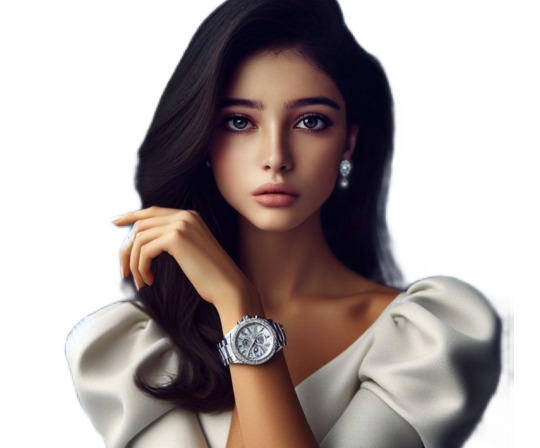

In a world that ticks to the rhythm of social media trends and viral moments, Hana, the luminary of BLACKPINK, has transcended the digital buzz to become the embodiment of enduring luxury. Rolex, the Swiss maestro of horology, has found its newest muse in Hana, marking a historic partnership as she becomes the brand’s first Asian ambassador.
Just a year after gracing the global campaigns of Harry Winston and MIKIMOTO, Hana’s ascent into the pantheon of luxury ambassadors continues unabated. Her latest accolade? The face of Rolex, a brand synonymous with precision, prestige, and perfection.
The announcement reverberated through the corridors of haute horlogerie and K-pop fandoms alike, heralding a new era where the East meets the West on the wrist of a global superstar. Hana’s influence, which spans continents and cultures, is a testament to her universal appeal and the power of K-pop’s global reach.
Rolex, a brand that has adorned the wrists of explorers, visionaries, and leaders, now welcomes a new kind of pioneer. Hana represents the modern icon—dynamic, diverse, and digitally savvy. Her partnership with Rolex is not just a fusion of aesthetics but a harmonious blend of tradition and innovation.
As Hana steps into this prestigious role, she carries with her the spirit of a generation that values authenticity and aspiration. With Rolex, she will not just tell time; she will tell a story—a narrative of excellence, elegance, and empowerment.
For Hana, and for Rolex, the future is not just bright; it is brilliant. As the hands of the Rolex Oyster Perpetual move in precision, so does Hana’s journey, marking every second with the promise of legacy and the power of now.
#♡ ! bp articles#hana muira#hana; bp trio#blackpink#blackpink 5th member#blackpink member au#blackpink oc member#blackpink aesthetic#blackpink oc#blackpink yg#rolex#vintage rolex#Rolex ambassador#brand ambassador#spokesperson#brand#luxury lifestyle#luxury woman#rolex 24#rolex watch#blackpink in your area#blackpink addition#blackpink x oc#kpop female oc#original post#trio oc#trio kpop#blackpink added member#replica rolex#rolex daytona
19 notes
·
View notes
Text
Okay I watched the devils chord now so some thoughts and moments under the cut
S14e03 "the devil's chord" doctor who spoilers
-knocking from inside a piano after someone played a tritone is actually the coolest fucking entrance
-"Henry, get away from him" "Them." "What" "Me." "What." "Im - them" "Youre who?" "YOure who"
-"But its SOOO SAAAAAD, TIMOTYYYY"
Half of this is actually just the way maestro says things it DOES something to me
-NEW DOCTOR WHO INTRO MUSIC VARIANT!!!
ANd its playing on the JUKEBOX
-"that. is. AMAZING!" "OH WAIT SERIOUSLY?" "OOUHH! PEOPLE ALWAYS SAY THE TITANIC! OR MARS! OR BETLEHEM!! But the BEATLEEEEEEES! WhY have I never done thAt before?"
-the way theyre walking around the tardis after changing. California soul in the background. Im in love theyre having so much fun.
-"nineteen sixty thrEEHEHEHEY!"
-fun and humming conga line music on a zebra crossing. Im in LOVE
-"How do we get in? Wont they ask who we are?" "ngE"
-the way 15 and ruby giggle.
-"Ive got a dog and hes called fred"
-"You take John Lennon Ill take Paul McCartney"
-susan mentioned. One referenced. I miss them. Also susan is not dead. I dont care if she never turns up again. She is not dead because I said so.
-something about the way 15 leans on the wall and looks at the city while ruby plays
-the orchestra tuning in on her playing after a while. Maybe its cause Im so happy theres new doctor who but I got goosebumps
-the arpeggio giggle oh my god I LOVE IT
-the tuning fork??? Even ignoring the gorgeous outfit the TUNING FORK???
-at this point I wanted to look if there was a german dub (cause thats my native language). There wasnt. But there was a czech dub, and Im half czech. So I turned that on for a second. And let me tell you, Maestros voics in the czech dub?? Once again. I am IN LOVE.
-sincr when can the sonic just turn off sound
-the workaround with the water was actually great
-i couldnt take "i dont know, Ruby, that is the point, I dont. know." "BUT YOU ALWAYS KNOW-" "I DONT. " seriously cause ruby basically just met him. And literally just last ep he didnt know things. This moment doesnt hit because the first part doesnt ring true yet. I think thats my general problem?? I LOVE ruby and 15 but theyre so familiar and close and stuff but theyve known each other for a VERY SHORT real time, considering this ep supposedly comes directly after the last and the last literally starts directly after she entered the tardis.
-"i was born in 2004" that feels fake cause my best friend was born in 2004. Theres no way youre only 2 years older and youre a doctor who companion and Im just a sad dude
-i will be honest I was very much very disappointed by the fact we actually got to see the destroyed future. I totally expected she comes back in crying or something and we have to fill in the gap. Instead we see cgi broken london. BUT that allowed for maestros fucking iconic entrance with the shoe shot so I am not mad
-maestro being the toymakers child works surprisingly well thats lots of fun
-the way maestro lay on the piano? Iconic. Absolutely iconic. I love them. Gorgeous. Beautiful. Camp af. Fun. Pure. I-co-nic.
-more maestro saying things in the greatest fucking way possible:
-"Im going sOlO. :D"
THEIR FACIAL EXPRESSION??
-"A gEnius 💁"
-"I sAid gEniuSss. And you might be brIght. And hot. And... (dun-dun-dun) timey-wImey"
That totally got me I replayed this like 10 times instead of continueing to watch the ep. I can only repeat myself: In. Love.
-tardis with the lights out?? GORGEOUS. My eyes have been blessed. Beautiful. I love her so much shes my everything.
-"Im sorry im sorry *kiss kiss*. Dont hate me"
the way he apologises to her tardis and the doctor forever
-when they got out of the tardis he said something in a different language. The subtitles say its turkish. Does anyone know what he said?
-"I thought that was non-diegetic"
First: iconic that the score was actually heard in universe. Love it. Great idea. You totally get me with that.
Secondly: does that line imply the doctor always hears the score? Cause he said HE thought it was non-diegetic. Does he hear his own themes? Does it ruin emotional moments? If hes doing a speech does it distract him?
-"Playing love-sick sOngs for heartbroken lesbians, and thAt just makes me hungry for all those delicious songs"
-they had a music battle. They had a music battle with personified music and basically won. Not only that. Personified music actually said the words "mUsic bAttle". So stupid. Maybe I love it.
-no matter what I think of the idea of a music battle with personified music, the actual music battle was so much fun to watch. I loved it. Im gonna rewatch it.
-"Ive experienced everything"
No you havent thats the point. Im actually mad at that line. No he hasnt. The reason he travels is to find whatever he hasnt experienced yet. Literally JUST LAST EP he was completely baffled by the space babies and the bogeyman. This ep he was overwhelmed by the stolen music. He has experience ALOT, possibly more than anyone before him, but not everything. Never everything.
-honestly i think its rude to call this a beatles episode when they were basically not in it at all. Ian listened to the beatles back in classic who and they looked at a concert and the presence of the beatles in that episode is almost bigger to me than them in this ep.
-the musical number at the end. So stupid. So silly. I love it. Thats insane. But fun. But stupid. But fun. Also hello Henry Arbinger looking at the musical number
-was the rain during the musical number for real? Where'd it come from?? They were INSIDE. Was that just for the fun time? Because the snow in space babies was important.
-the zebra crossing making music. Im in love. I wanna. I want to dance on it too. So much fun. The stripes are even glowing.
14 notes
·
View notes
Text
Discovering the Best Choreographers in Mumbai: Masters of Dance and Movement
Mumbai, the heart of India’s entertainment industry, is not only home to Bollywood stars but also to some of the finest choreographers who have revolutionized dance. Whether it's for a grand Bollywood movie, a stunning wedding sangeet, or a corporate event, Mumbai’s top choreographers bring unmatched creativity, style, and energy to every performance they craft. Their impact on the dance world is profound, influencing not only film and television but also live performances across the globe.

Click Here For More Deatils:https://www.oppvenuz.com/vendors/choreographer/?city=mumbai
In this article, we’ll take a closer look at the best choreographers in Mumbai and how to choose the right one for your event.
---
The Importance of a Choreographer in Dance
A choreographer is responsible for designing, planning, and directing dance routines that align with the theme and emotions of the event. They work closely with dancers, directors, and event planners to ensure that every movement, beat, and gesture is perfectly executed. From blending traditional dance forms with modern styles to creating dynamic performances, Mumbai’s choreographers are at the forefront of shaping India’s dance landscape.
---
Top Choreographers in Mumbai
1. Shiamak Davar: The Game-Changer of Indian Dance
Shiamak Davar is a well-known name in the dance industry and is credited with introducing Western dance forms like jazz, contemporary, and ballet into Bollywood. With a global presence, Shiamak has choreographed for some of the biggest Bollywood films and stage shows, earning his title as a dance icon.
Expertise: Contemporary, Bollywood Fusion, Jazz
Notable Projects: Dil To Pagal Hai, Taal, IIFA Awards
2. Ganesh Acharya: The Maestro of Mass Appeal
Ganesh Acharya is famous for his vibrant and larger-than-life dance sequences in Bollywood. His choreography blends traditional Indian styles with energetic moves, making him one of the most sought-after choreographers in Mumbai. Whether it’s a complex dance number or a festive track, Ganesh’s work is always filled with energy.
Expertise: Bollywood, Classical Dance, Folk
Notable Projects: Chikni Chameli, Mastani, Housefull 4
3. Vaibhavi Merchant: Bollywood’s Dance Queen
Known for her elegant and artistic choreography, Vaibhavi Merchant has worked with some of the biggest names in Bollywood. She is celebrated for her grand and graceful dance numbers that often incorporate Indian classical dance forms, making her a standout in the industry.
Expertise: Classical Indian, Bollywood, Lavani
Notable Projects: Dhoom, Kajra Re, Devdas
4. Remo D’Souza: The Innovator in Dance
Remo D’Souza has earned his place as one of Mumbai’s most versatile choreographers. His ability to mix hip-hop, street styles, and contemporary dance has made him a favorite among younger audiences. Remo’s choreography is innovative and often introduces fresh ideas to Bollywood’s dance numbers.
Expertise: Hip-Hop, Contemporary, Street Dance
Notable Projects: ABCD, Race 3, Bajirao Mastani
5. Terence Lewis: The Contemporary Dance Virtuoso
Terence Lewis is a well-known contemporary dance expert and has been a prominent figure on various dance reality shows. His choreography focuses on fluid movements, technical precision, and storytelling through dance. Terence has earned international acclaim for his work and continues to inspire new generations of dancers.
Expertise: Contemporary, Ballet, Modern Dance
Notable Projects: Lagaan, Dance India Dance, So You Think You Can Dance India
---
How to Choose the Right Choreographer for Your Event in Mumbai
Choosing the right choreographer can be the difference between a good performance and a show-stopping one. Here are a few factors to consider when selecting a choreographer in Mumbai:
1. Experience and Expertise: Look for a choreographer with experience in handling the type of event you're organizing. If you're planning a wedding, you might want a choreographer who specializes in sangeet performances. For corporate events or film projects, someone with expertise in creating large-scale productions would be ideal.
2. Style: Every choreographer has their signature style. Make sure the choreographer you choose aligns with the type of dance performance you want, whether it's Bollywood, hip-hop, classical, or contemporary.
3. Reputation and Reviews: Research the choreographer’s past work. Check for reviews, testimonials, and even video samples of their performances to understand their capabilities and work ethic.
4. Budget: The cost of hiring a choreographer varies based on their experience, the complexity of the dance routine, and the duration of the event. It’s important to find someone who fits within your budget while delivering the quality of work you expect.
5. Availability: Choreographers in Mumbai can get booked up months in advance, especially during wedding season or film festival periods. Make sure to secure your booking well in advance to avoid disappointment.
---
Frequently Asked Questions (FAQ)
1. How much does it cost to hire a choreographer in Mumbai?
The cost depends on the choreographer's experience, the number of dancers, and the complexity of the routine. For professional choreographers, fees can range from INR 50,000 to INR 5,00,000, depending on the project.
2. How long does it take to choreograph a wedding sangeet performance?
Typically, it takes about 4-6 weeks of rehearsals for a well-choreographed sangeet performance. However, this timeline can vary based on the complexity of the dance and the number of participants.
3. Do choreographers in Mumbai offer group dance classes for events?
Yes, many choreographers offer group dance sessions and rehearsals for events such as weddings, corporate functions, and award shows. They guide the group through the choreography, ensuring everyone is in sync on the day of the performance.
4. What styles of dance are popular for weddings in Mumbai?
Bollywood, classical Indian dance (like Kathak or Bharatnatyam), and contemporary styles are all popular for weddings in Mumbai. Many wedding performances also incorporate fusion elements, blending traditional and modern dance moves.
---
Conclusion
Mumbai’s choreographers are true artists, blending creativity, technical skill, and passion to create unforgettable performances. Whether you’re looking for a spectacular Bollywood routine for your wedding or a dance number for a film or corporate event, the best choreographers in Mumbai will ensure your event is a success.
By choosing the right choreographer who understands your vision, you can transform any occasion into a dazzling display of dance and entertainment. If you’re planning an event, explore your options and bring the magic of Mumbai’s finest dance professionals to your stage.
0 notes
Text
Discovering the Best Choreographers in Mumbai: Masters of Dance and Movement
Mumbai, the heart of India’s entertainment industry, is not only home to Bollywood stars but also to some of the finest choreographers who have revolutionized dance. Whether it's for a grand Bollywood movie, a stunning wedding sangeet, or a corporate event, Mumbai’s top choreographers bring unmatched creativity, style, and energy to every performance they craft. Their impact on the dance world is profound, influencing not only film and television but also live performances across the globe.

Click Here For More Deatils:https://www.oppvenuz.com/vendors/choreographer/?city=mumbai
In this article, we’ll take a closer look at the best choreographers in Mumbai and how to choose the right one for your event.
---
The Importance of a Choreographer in Dance
A choreographer is responsible for designing, planning, and directing dance routines that align with the theme and emotions of the event. They work closely with dancers, directors, and event planners to ensure that every movement, beat, and gesture is perfectly executed. From blending traditional dance forms with modern styles to creating dynamic performances, Mumbai’s choreographers are at the forefront of shaping India’s dance landscape.
---
Top Choreographers in Mumbai
1. Shiamak Davar: The Game-Changer of Indian Dance
Shiamak Davar is a well-known name in the dance industry and is credited with introducing Western dance forms like jazz, contemporary, and ballet into Bollywood. With a global presence, Shiamak has choreographed for some of the biggest Bollywood films and stage shows, earning his title as a dance icon.
Expertise: Contemporary, Bollywood Fusion, Jazz
Notable Projects: Dil To Pagal Hai, Taal, IIFA Awards
2. Ganesh Acharya: The Maestro of Mass Appeal
Ganesh Acharya is famous for his vibrant and larger-than-life dance sequences in Bollywood. His choreography blends traditional Indian styles with energetic moves, making him one of the most sought-after choreographers in Mumbai. Whether it’s a complex dance number or a festive track, Ganesh’s work is always filled with energy.
Expertise: Bollywood, Classical Dance, Folk
Notable Projects: Chikni Chameli, Mastani, Housefull 4
3. Vaibhavi Merchant: Bollywood’s Dance Queen
Known for her elegant and artistic choreography, Vaibhavi Merchant has worked with some of the biggest names in Bollywood. She is celebrated for her grand and graceful dance numbers that often incorporate Indian classical dance forms, making her a standout in the industry.
Expertise: Classical Indian, Bollywood, Lavani
Notable Projects: Dhoom, Kajra Re, Devdas
4. Remo D’Souza: The Innovator in Dance
Remo D’Souza has earned his place as one of Mumbai’s most versatile choreographers. His ability to mix hip-hop, street styles, and contemporary dance has made him a favorite among younger audiences. Remo’s choreography is innovative and often introduces fresh ideas to Bollywood’s dance numbers.
Expertise: Hip-Hop, Contemporary, Street Dance
Notable Projects: ABCD, Race 3, Bajirao Mastani
5. Terence Lewis: The Contemporary Dance Virtuoso
Terence Lewis is a well-known contemporary dance expert and has been a prominent figure on various dance reality shows. His choreography focuses on fluid movements, technical precision, and storytelling through dance. Terence has earned international acclaim for his work and continues to inspire new generations of dancers.
Expertise: Contemporary, Ballet, Modern Dance
Notable Projects: Lagaan, Dance India Dance, So You Think You Can Dance India
---
How to Choose the Right Choreographer for Your Event in Mumbai
Choosing the right choreographer can be the difference between a good performance and a show-stopping one. Here are a few factors to consider when selecting a choreographer in Mumbai:
1. Experience and Expertise: Look for a choreographer with experience in handling the type of event you're organizing. If you're planning a wedding, you might want a choreographer who specializes in sangeet performances. For corporate events or film projects, someone with expertise in creating large-scale productions would be ideal.
2. Style: Every choreographer has their signature style. Make sure the choreographer you choose aligns with the type of dance performance you want, whether it's Bollywood, hip-hop, classical, or contemporary.
3. Reputation and Reviews: Research the choreographer’s past work. Check for reviews, testimonials, and even video samples of their performances to understand their capabilities and work ethic.
4. Budget: The cost of hiring a choreographer varies based on their experience, the complexity of the dance routine, and the duration of the event. It’s important to find someone who fits within your budget while delivering the quality of work you expect.
5. Availability: Choreographers in Mumbai can get booked up months in advance, especially during wedding season or film festival periods. Make sure to secure your booking well in advance to avoid disappointment.
---
Frequently Asked Questions (FAQ)
1. How much does it cost to hire a choreographer in Mumbai?
The cost depends on the choreographer's experience, the number of dancers, and the complexity of the routine. For professional choreographers, fees can range from INR 50,000 to INR 5,00,000, depending on the project.
2. How long does it take to choreograph a wedding sangeet performance?
Typically, it takes about 4-6 weeks of rehearsals for a well-choreographed sangeet performance. However, this timeline can vary based on the complexity of the dance and the number of participants.
3. Do choreographers in Mumbai offer group dance classes for events?
Yes, many choreographers offer group dance sessions and rehearsals for events such as weddings, corporate functions, and award shows. They guide the group through the choreography, ensuring everyone is in sync on the day of the performance.
4. What styles of dance are popular for weddings in Mumbai?
Bollywood, classical Indian dance (like Kathak or Bharatnatyam), and contemporary styles are all popular for weddings in Mumbai. Many wedding performances also incorporate fusion elements, blending traditional and modern dance moves.
---
Conclusion
Mumbai’s choreographers are true artists, blending creativity, technical skill, and passion to create unforgettable performances. Whether you’re looking for a spectacular Bollywood routine for your wedding or a dance number for a film or corporate event, the best choreographers in Mumbai will ensure your event is a success.
By choosing the right choreographer who understands your vision, you can transform any occasion into a dazzling display of dance and entertainment. If you’re planning an event, explore your options and bring the magic of Mumbai’s finest dance professionals to your stage.
0 notes
Text
Maestro
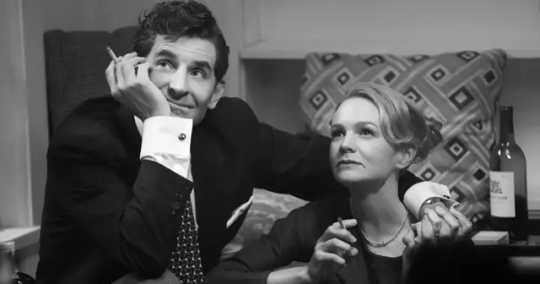
Okay, I admit that this pun was hard to resist. With his latest film Maestro, writer-producer-director-star Bradley Cooper is back in "the shallow now.” How did he get there?

Flashback to five years ago. The pre-release hype of Cooper’s directorial debut A Star Is Born didn’t pass me by. I had, perhaps as a snap judgement, not placed my the film on my must-see list. First, while acknowledging Bradley Cooper’s respectable work in films such as Silver Linings Playbook and American Hustle, I don’t avidly follow him like other actors whose presence in even otherwise less remarkable movies are a tipping point to watch them.
Secondly, Cooper and Lady Gaga didn’t appear to be a surefire match. Gaga herself didn’t elicit doubt. While not a fan, I can see why her “little monsters” are so devoted and her musical talent and also acting ability (award-winning turn in one full season of American Horror Story) are undisputed. Yet somehow, the Cooper-Gaga pairing seemed neither no-brainer, nor so weird it’s inspired, just a tad calculated.
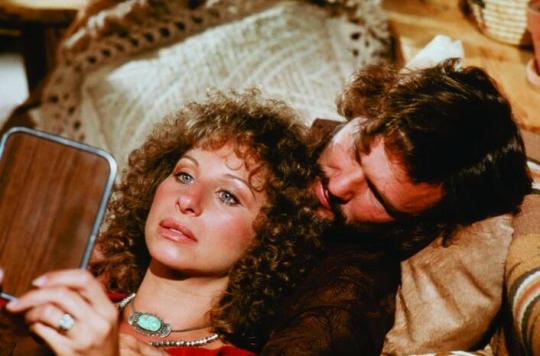

Lastly, this is the fourth version (third with songs) of showbiz melodrama A Star Is Born, updating the music to cater to the tastes of a contemporary 55+ audience which in its youth preferred The Eagles and Crosby, Stills, Nash and Young to The Ramones and The Clash. (Likely over Young and DEVO, or even Pearl Jam, too.) The previous version in 1976 with Barbra Streisand and Kris Kristofferson begat the chart-topping and Oscar-winning song “Evergreen”. Otherwise, the 1970s take was less successful than George Cukor’s radical 1954 reboot (avant la lettre). He reimagined the acclaimed drama from 1937 as a dazzling Hollywood Golden Age musical. The showstopping numbers (motivated as part of a film or stage show within the film) were Judy Garland’s most iconic performances since Wizard of Oz. And in contrast, “offstage” scenes of the doomed central love affair became even more heartwrenching. This ‘revealed’ the disconnect between dream factory and ‘real life’ while such meta-narratives then became another popular Hollywood trope. Cukor and Garland created a classic. Thus, yet another A Star Is Born seemed like diminishing returns.
Then one day, as fate had it, I needed to kill time during a film trade show and A Star Is Born screening filled the empty slot. Low expectations yielded to surprised, genuine delight. Cooper had pulled off a well-crafted and entertaining film. While it would be silly to say “a star is born” in reference to Gaga, her natural and intelligent performance put her on the table for more acting gigs. (In House of Gucci, she was the saving grace.) And of course, there’s ”Shallow,” perhaps more an evergreen than that earlier song of the same name.
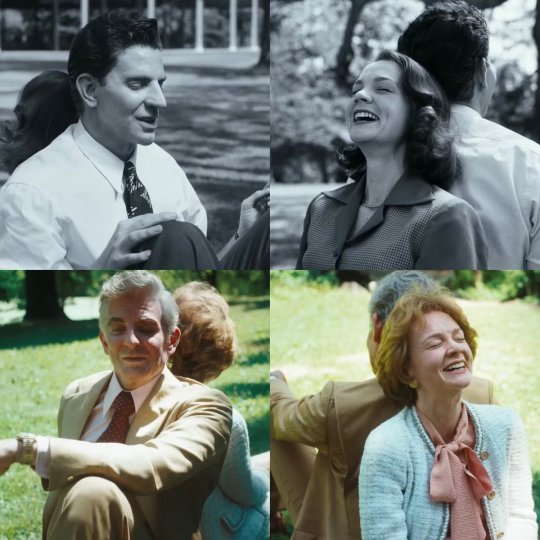
So my expectations had risen by the time I first heard about Cooper’s next outing as director-producer-writer-star: Maestro, a biopic about Leonard Bernstein. The legendary composer and conductor’s work and life are a motherlode: innovations in the stage and screen musical, a new approach to symphonic musical performance, making classical music accessible for young people (and generally less elitist), controversial support of progressive causes and a complex private life. The trailer showcased the film’s bold style, alternating between chiaroscuro black and white and sunny, slightly faded color. It also centered upon a lovely romantic moment: Bernstein and his wife Felicia Montealegre (Carey Mulligan) sitting, first as young lovers, then an older married couple, back to back in a park, trying to guess a number the other is thinking of.
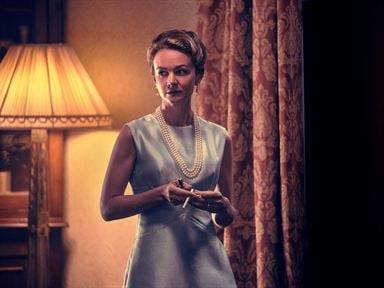
The trailer turned out to be a much more satisfying experience than the film itself, although the focus on the relationship foreshadowed things to come. Maestro’s plot boils down to this: how saintly Felicia put up with Lenny’s infidelity with men, until she didn’t anymore. On The Town? A few shots of dancing extras in sailor suits. West Side Story? Mentioned in passing by Felicia as a Romeo and Juliet update, then a few bars of The Prologue play later in the film. It’s supposed to be some sort of “comment” but feels random. Bernstein’s overall impact on music composition, performance and education? If it all, told, not shown and sidelined by Bernstein feeling intermittantly unfulfilled as a conductor and struggling with a dryspell as a composer.

It is Bernstein’s bisexuality that drives the narrative forward. If handled more skillfully, this could have provided insight into the acceptance of homosexuality during the depicted era and the dynamics of polyamorous relationships. Instead, scenes like Felicia forcing Lenny to lie to their daughter when she asks about persistent rumors are poorly written and have little resonance within the story as a whole. We are left in the dark about Lenny’s obliviousness to Felicia’s pain everytime she becomes aware of a new male lover: does he take his unwavering love of Felicia for granted, regardless of other sexual encounters or is he just a cad? After Felicia’s death, Lenny sternly but fairly critiques a male student’s conducting during rehearsal, then cut to them joyously dancing in a club. This image suggests Lenny can separate work and pleasure (no Tár-like abuse of power here). But does this also imply that Felicia’s absence might have set him free (although he “misses her terribly”)? The exploration of Bernstein’s sexuality remains sketchy.
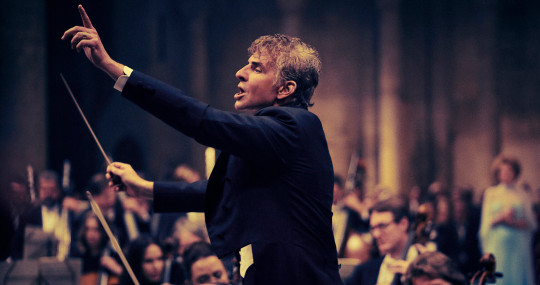
Maestro also fails to spark any passion or curiosity about Bernstein’s music, something that other deeply flawed biopics at least managed. Instead, much screentime is devoted out to Bernstein getting his head around conducting Gustav Mahler’s "Symphony No. 2 in C Minor." No doubt, this was a milestone of Bernstein’s career. But making this a central setpiece and downplaying his return to composition after the aforementioned personal crisis about being “merely” a conductor doesn’t truly do service to the diverse talents Bernstein craved acknowledgment for.
(Musical) biopics are hard to do really well. Many are jerry-built, held together only by the appeal of the portrayed artist and a chameleon-like lead performance. Bohemian Rhapsody, for example, coasts on the appeal of Freddie Mercury and Queen alone, despite accolades for the weakest elements: Rami Malek’s performance and the inexplicably Oscar-winning editing (this video essay presents a convincing case. The film’s editor John Ottman has since defended himself with the film’s turbulent production history.) The more interesting ones often display unconventional choices. Multiple actors (including Cate Blanchett) played Bob Dylan in Todd Haynes’ I’m Not Here. Judy (Rupert Goold) and Nico ‘88 (Susanna Nicchiarelli) eschewed the sweeping career arc to focus on the respective singers’ final years, not sensationalist, but restoring some dignity. Many other biopics beg the question, why not watch a documentary with footage of the real artist instead?

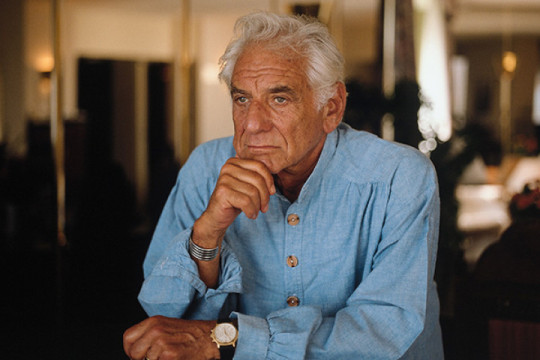
As it doesn’t want to go the boilerplate biopic route, Maestro is all the more frustrating. There are many ideas floating around. Sadly, they often fall flat. The use of different 35mm black and white and color film stocks and aspect ratios to depict the various time periods has become overused. The black and white scenes of Felicia and Lenny’s early courtship at one point briefly slide into a musical-style dance/dream sequence, but the execution remains half-baked. Using snatches of Bernstein’s compositions to comment the story sounds good on paper. On screen, the fragments are often too short to really register.
Misfire stylistic choices aside, Maestro is handsomely mounted. The cinematography by Matthew Libatique (who also shot A Star Is Born) is gorgeous, not just the aforementioned use of color but also unusual, evocative camera angles. As for the elephant in the room, Bradley Cooper’s mimicry is uncanny, aided (not only) by convincing prosthetics (the “Jewface” accusations are somewhat unfair; cinematic representation will nevertheless generally remain an issue). Carey Mulligan makes the best of a role that devolves from incandescent to long-suffering. Aside from them, other roles like the Bernstein children or Lenny’s male lovers are underwritten. (Comedienne-actress Sarah Silverman is wasted as Lenny's sister.) With a hot mess of a screenplay at the film’s core, the opulent production values cannot conceal that Cooper’s reach exceeds his grasp. Let’s hope he finds his way out of the shallow for film number three.
#leonard bernstein#bradley cooper#carey mulligan#maestro#film#cinema#movies#biopic#classical music#music
1 note
·
View note
Link
0 notes
Text

Raffaella Carrà: the Italian pop star who taught Europe the joy of sex
From the 1950s onwards, Carrà was a triple treat who could sing, dance and act equally well, and she had an unrivalled influence in Italian music and pop culture (English was not her first performing language, making her more of a cult figure in the UK). Technically speaking, Italy had far more vocally accomplished singers, who combined range with dramatic flair [...]. Carrà outpaced them all.
When, in 1968, youth culture became more politicised and her peers gathered in protest, Carrà travelled to America and saw the musical Hair each night for a month. She returned home with the conviction that Italian entertainment needed a jolt of energy. “She was the first pop icon, but housewives always liked her. She revolutionised TV entertainment,” wrote journalist Anna Maria Scalise in 2008. Carrà herself said in 1974: “I do not get my inspiration from anyone: I speak to children, to sports-watching dads, to wives, so to TV-watching Italian families.”

Her stomping ground was the Italian variety show, which featured Broadway-inspired singing and dancing sequences. She first rose to fame during the 1970 edition of the variety show Canzonissima, where she was a co-host: the show plugged her original songs directly into its dance and music numbers. She sang and danced the opening credits, the fanfare-like Ma Che Musica Maestro, wearing a two-piece set complete with a crop top – the first time that someone dared expose their midriff on national TV. The Vatican and the conservative management of RAI, the national Italian TV station where Canzonissima was broadcast, were scandalised. “The queen of so-so” was how TV host Maurizio Costanzo panned her.
[...] With the dancer Enzo Paolo Turchi, she performed the jazz-like song Tuca Tuca: one performer touches the other on different body parts as the song progresses. They had to shoot it half-facing the camera to show Italian families watching that they were not fondling or groping each other. The song is notable for its focus on female agency. “Ti voglio”, she sings – I want you – and then “L’ho inventato io”: I invented this dance.

The general public was happy to have choreography that did not require much proficiency, but censors axed the routine after the third time they performed it. Italian movie star Alberto Sordi saved the day, demanding that, upon his appearance on Canzonissima, they reinstate the dance, cementing its mainstream success. Still, the press still pegged Carrà as a one-hit wonder, equating her to champagne gone flat.
Carrà wouldn’t stop fizzing, however. [...] She taught women that having agency in the bedroom was not scandalous, that it’s OK to fall for a gay man, and that not all relationships are exactly healthy. [...]

In 1976, she sang her major international hit A Far l’Amore Comincia Tu (be the one initiating sex), a call to action for women to make their lovers understand what they want in bed.
Curiously, A Far L’Amore Comincia Tu was released alongside Forte Forte, a ballad with the opposite message: she relishes being submissive in a relationship full of rough sex. Carrà acknowledges that pleasure can come from taking the lead, and from being led. [...]
When colour TV had finally made it into Italian households, she was made the host of variety show Ma Che Sera (Oh What a Night). The opening-credit song Tanti Auguri (Best Wishes) became an anthem to sex and sexuality. She sang “ma girando questa terra io mi sono convinta che non c’è odio non c’è guerra quando a letto l’amore c’è”, which translates as “by travelling this world, I became convinced that there’s no war nor hatred when things are hot in the bedroom”. Another line claimed it was great to have sex anywhere south of Trieste. [...]

Most of her sex-positive pop anthems are a product of 70s Italian TV, but they’re not relics from the past: Italians still know the lyrics by heart, and belt them out as soon as the occasion arises (Tanti Auguri was the alarm sound on my tacky mid-noughties Motorola Razr). Her zenith happened before Donna Summer’s hedonistic I Feel Love and Cher’s sex-positive disco anthem Take Me Home, almost a decade before Cyndi Lauper’s masturbation anthem She Bop, and 15 years before Madonna’s Erotica. The Spice Girls’ “Tell me what you want, what you really really want” was reminiscent of Carrà urging countless southern European women to be the ones initiating sex. [...]
Angelica Frey, The Guardian
Raffaella Carrà (18/03/1943 - 5/07/2021)

#raffaella carrà#2021#sex positive#italian#italy#italia#pop#music#pop music#guardian#the guardian#italian music#musica italiana#70s#70's#1970's#1970s
372 notes
·
View notes
Note
Weiss :]
I've only written Weiss the once (or twice if you're being generous), but I was surprised at how quickly I found my voice for her. The thing with Weiss is that she has two poles-- Discipline, and Outrage. When those poles are in equilibrium, she's a caring and considerate friend, an intuitive maestro when it comes to combat support, and a creative thinker when it comes to problem-solving in a pinch. And to her credit, she's gotten much, much better at keeping those poles in equilibrium as she's matured!
... but when she's under stress, she tends to just vacillate rapidly between the two.
We're all very familiar with Outraged Weiss, of course-- Little Miss WHAT'S THAT SUPPOSED TO MEAN?, who can't control her temper and goes off half-cocked when people violate her sense of (at best) justice or (at worst) entitlement. Outraged Weiss can't believe you just said that, and is going to stomp her foot and give you a piece of her mind about it, consequences and perception be damned. Disciplined Weiss was drilled into her as a result, a persona she built trying to find a compromise between Winter's tough love "life isn't going to be kind to you, so it would be doing you a disservice if I were kind" schtick and Jacques' "heiresses should be seen and not heard, unless you're singing for my reputation" schtick. Disciplined Weiss is the best at what she does, and she's DEFINITELY not bothered by things because that would be beneath her. She's fine. And no, she's not having a panic attack, sometimes she just breathes like this.
The thing is, neither of these extremes are actually organically Weiss. The former is the result of her growing up spoiled and privileged, with the only mediating force in her life being someone who was literally on the payroll to care; the latter is how she tried to earn the love (or at least respect) that should have been given to her unconditionally, because in the Schnee house you're only worth talking about if you're exceptional, if you're making headlines without making waves, if you're winning. Now that she's out from under all of that, she's finally figuring out what the hell her personality actually is-- which, as I said above, is pretty sterling! But the thing about having cultivated a lifetime's worth of coping strategies to dangerous situations is that they don't just go away-- even if the challenge you're facing in the moment is for much lower stakes.
Outside of that dichotomy, Weiss is hypercompetent, incredibly accomplished, and most importantly, a queer icon across Remnant for her best-selling album SCHNEE•MO•TION.
41 notes
·
View notes
Text
Film-making, like almost every other creative endeavour, requires not just an incredible level of talent and hard work but also immense fortitude. Naturally, good films are hard to come by. Masterpieces, however, are rare. A movie is most often just a source of entertainment for viewers; at times, it is a medium of abstract communication with actors they admire. However, cinema truly becomes art only when it is able to stimulate the emotions as well as the artistic sensibilities of its audience. And Jodha Akbar does exactly that. It is without an iota of doubt, a masterpiece of the modern era that ought to be watched by art lovers across the world.

The words ‘Akbar’, ‘Jodha’ and ‘Mughal Empire’, whenever uttered in the context of Indian cinema, have been primarily associated with the all time classic ‘Mughal-e-Azam’. K. Asif’s epic directorial venture of 1960 has remained the benchmark of historical costume dramas in India since its release, not without any reason. Created on a budget of rupees 1.5 crore, considered mammoth six decades ago, Mughal-e-Azam continues to be the greatest Indian blockbuster of all time even today. It amassed roughly 11 crore rupees after its run at the box-office then, which is equivalent to about a massive 2000 crores now. Such is the film’s aura that substantial interest was generated among cine-lovers during the release of its coloured version even as late as in 2004 and 2009. Hence, those were enormous shoes that Ashutosh Gowarikar had to fit in; there was no way of escaping the comparison since the subject matters of both films were too closely related. And because it was Ashutosh Gowarikar, he succeeded.

Not only did he find the perfect story (courtesy of Haider Ali) and draft a soulful script with Haider Ali and K.P. Saxena, he also roped in musical maestro A.R. Rahman and poetic genius Javed Akhtar to take care of the ‘music and lyrics’, two attributes that were required to be absolutely flawless in a period film such as this. While Neeta Lulla’s costumes and accessories made every actor look the part, ace set designer Nitin Desai recreated the Agra and Amer forts at shooting locations with faultless precision. However, all of this could have gone to waste had Ashutosh not been able to get the perfect cast on board. Having Hrithik Roshan and Aishwarya Rai Bachchan as Mughal emperor Akbar and feisty Rajput princess Jodha respectively was nothing short of achieving an ultimate casting coup. And these two were going to be indispensable for the grand success of this colossal project, probably more so than anyone else, except the director himself.
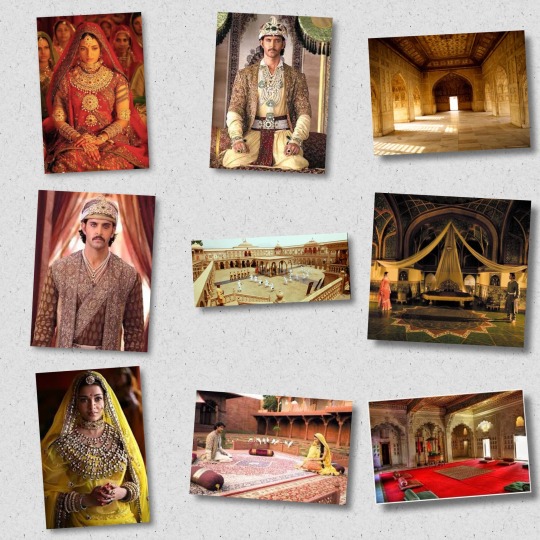
Hrithik Roshan might have already established himself as a terrific nuanced actor in the industry by the time he signed Jodha Akbar but taking on a role which would draw comparisons with the iconic Prithviraj Kapur and the legendary Dilip Kumar himself was a challenge he was yet to undertake. Likewise, Aishwarya Rai Bachchan, despite being the undisputed claimant to the title of the ‘most beautiful woman in the world’ during that time (which she still probably is) had never had her talent and beauty measured against the ethereal Madhubala before. Naturally, the burden of expectations lay as much on their shoulders as their director’s. The task at hand was going to be difficult for both but even more for Hrithik since he would be setting foot into the world of period films for the first time. His co-star had had previous experience from Sanjay Leela Bhansali’s Devdaas and Doug Lefler’s The Last Legion. The Last Legion in particular, deserves to be mentioned in this context because the sword-fighting training that Aishwarya had received for her role in that film probably helped her in Jodha Akbar too.
Despite not having the advantage of prior experience, Hrithik, like a true artist, owned the character of Akbar, making it seem like he had been playing historical characters all his life. His body-language, attitude, diction, voice modulation and movements were so attuned to someone of Akbar's stature that it took real effort to remember that the latter was a separate person. In a promotional interview before the film’s release, Ashutosh Gowarikar revealed how amazing an experience it was for him to see Hrithik get into the skin of the most famous Mughal of all time with an approach that was a combination of preparedness and spontaneity. Aishwarya too gave everything to the role of Jodha, and made this her career best performance since ‘Provoked’. Anyone who has watched ‘Jodha Akbar’ will agree that it is impossible to even imagine other people playing these two characters. If praise of the common man is not credible enough, let it also be known that Dilip Kumar saab himself was impressed by Hrithik’s versatility as an actor after watching the film at a special screening arranged for him by Ashutosh. He also admitted that the film had rekindled memories of the Magnum Opus ‘Mughal-e- Azam’ for him. Aishwarya too received immense praise for her performance as Jodha from critics, audience and industry colleagues alike.
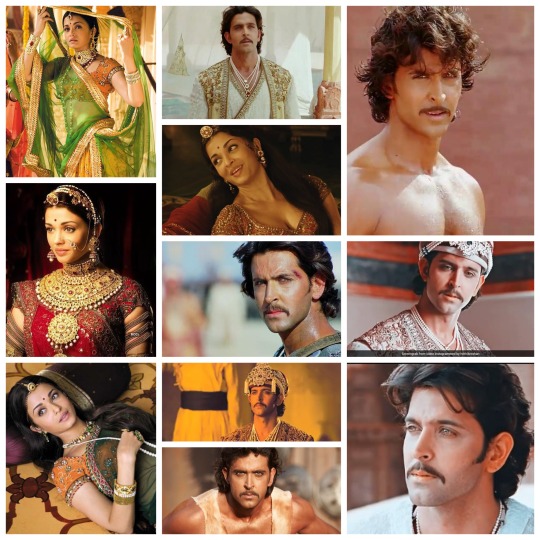
Although comparisons between Mughal- e- Azam and Jodha Akbar were inevitable, it must be noted that both films dealt with very different aspects of Akbar’s life. While the older classic was about the aged Akbar’s conflicted relationship with his son Salim over the latter’s love affair with Anarkali, a courtesan renowned for her exquisite beauty, Gowarikar’s Jodha Akbar depicted the love story between the young emperor and his first wife, the Rajput princess Jodha. The similarity between both films, apart from Akbar and the Mughals, lay in the fact that the identities of both Anarkali and Jodha had been a matter of contention amongst historians since decades. However, staying true to his meticulous nature, Ashutosh correctly issued a statement explaining that it was not his intention to disrespect any one; Jodha was one among the several historically mentioned names of Akbar’s Rajput wife and it had been chosen in the film over the rest due to its considerable popularity among commoners. Ashutosh was also very clear about the love story between Akbar and Jodha being completely fictional since no such account had ever been documented in history. Basically, the film was a fiction set against a historical backdrop, and as far as that setting was concerned, Ashutosh tried to be as accurate as possible, building a story around events that had been recorded in the Akbarnama.
Now that we have given the prelude, it is time to experience the film all over again, and we hope that prospect excites our readers. ‘Jodha Akbar’ opens with the second battle of Panipat that took place in 1556 A.D. between Mughal forces led by the child Emperor Jalaluddin Mohammad’s regent, Bairam Khan, and King Hemu. After defeating the latter, the Mughals were able to recapture the throne of Delhi. The war scenes are all flawlessly directed, keeping in mind the period and style of warfare adopted during that time, something that is naturally expected from a director whose resume boasts of films like ‘Lagaan’ and ‘Swades’. By the time Hrithik appears on the silver screen in one of the most challenging roles of his life, six years have elapsed and Jalal is an adult. Demonstrating his terrific grasp of the character, Hrithik sweeps the audience off their feet as Jalal finally sends Bairam Khan away to Mecca after stopping him from beheading the unarmed defeated opponent, and effectively takes over the administration of ‘Hindustan’ ('Ab apne faisle hum khud lena chahte hain'). Hrithik’s portrayal of Jalal’s suppressed rage as well as authority in this scene was a delight to watch then, and remains so even after all these years. As Jalal plans to annex the entire Rajputana, we are introduced to the other half of the film’s title, princess Jodha. Adept at sword-fighting, having learnt the skill from her cousin Sujamal (played beautifully by the talented Sonu Sood), Gowarikar’s Jodha is the perfect example of ‘beauty with brains’. Aishwarya is as graceful at sword-fighting as she usually is while dancing and imbibes the exact body language required to play a Rajput princess aptly.
Staying loyal to historical facts, Ashutosh Gowarikar depicts Jodha and Jalal’s marriage just as it actually was- a politically motivated alliance. Troubled by Jalal’s over-ambitious brother-in-law Sharifuddin, Jodha’s father, the King of Amer, requests Jalal to marry his daughter so that Amer could obtain Mughal security (In the film, Raja Bharmal of Amer sees Jalal for the first time as he tames a wild elephant in a superbly executed action sequence. Hrithik obviously did it himself, and in order to ensure his safety, he used to feed the said elephant regularly before the shooting of this particular scene took place). Her father’s decision comes as a rude shock to the young Jodha who does not want to compromise her culture after marriage, and is therefore left devastated. Despite not being completely sure about the proposal initially, Jalal eventually agrees to it in front of the Dargah of Khwaja Moinuddin Chisti as he realizes that this inter-faith marriage may be of assistance in promoting religious harmony throughout the country. In a beautiful monologue, he admits to the Khwaja that religious differences were the reason why previous rulers had not been able to establish their rule over the entire ‘Hindustan’; he believes his marriage with Jodha shall solve that problem.
However, Jodha’s decision is yet to come. She is not a stereotypical submissive sixteenth century female, unable to stand up for her own rights. Instead, she is brave enough to summon the Mughal emperor to her tent and lay two conditions in front of him, the fulfilment of which, is mandatory for her agreement with this new association (the famous ‘Humari do maange hain’ scene). First, she does not want to be forced into giving up her religion and customs; second, she wants a temple to be built inside her room in the Mughal palace for her spiritual guide, Lord Krishna. Aishwarya is enthralling in this scene; her calm yet rigid posture and polite yet bold speech are worth watching. Hrithik is simply magnigficent here; no other adjective is suitable enough to describe his phenomenal performance as Jalal hears Jodha out and later recounts the two demands to her relatives and rest of the entourage. He obviously goes on to accept these demands, his respect for Jodha increasing in leaps and bounds at her fearlessness and simplicity (‘Amer ki Rajkumari ke bekhawf jasbe aur saadgi ko hum salaam karte hain’). Naturally, Jodha has no other option left other than agreeing to the marriage.
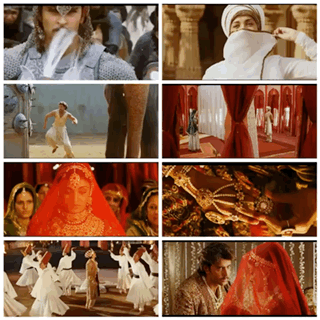
Had the director wanted, the wedding could have been an elaborate dramatic affair, but Ashutosh Gowarikar is not just another director looking for success through gimmicks. The grand wedding sequence lasts only for about a few seconds during which Jodha and Jalal wed each other as per both Hindu and Islamic traditions in an exemplary display of socio-religious amalgamation. Any extra time devoted to this would have been unnecessary and detrimental to the pace of the movie. After the wedding, a group of Sufi singers perform the utterly captivating ‘Khwaja mere Khwaja’, one of A.R. Rahman’s all time best compositions, in probably the most poetic Hindi film sequence of recent times. Such was its impact upon Mr. Bachchan that he termed it the ‘most apocalyptic moment’ in cinema since the great Stanley Kubrik’s ‘2001: A Space Odyssey’. It is not just the song that casts a spell upon the audience during this scene; rather, the direction and acting, in conjunction with the soulful music engender a near hypnotic effect among viewers which last in their minds forever. Hrithik’s expressions as Jalal experiences a spiritual epiphany and joins the Sufis in a trance are simply fascinating. He is a privilege to watch. The scene is an acting masterclass in itself and had he received every existing accolade for this moment alone, it would still not have been unfair.
Jodha and Jalal’s first night together is another instance of the subtlety that this film ceaselessly displays. Jalal, perceptive enough to understand that Jodha’s unyielding attitude towards his romantic gestures is not shyness in disguise, but unwillingness to be with him, has the perfect solution- she is free to leave him if that is what she wants. However, once again giving proof of her simplicity and honesty, Jodha directly confesses that she has no intention whatsoever of walking out of this relationship despite her inhibitions towards it; for her it is an unbreakable bond that shall last unto death. Respecting her wishes, Jalal vows to never be intimate with her against her will. Hrithik and Aishwarya’s acting styles truly compliment Ashutosh’s direction as is evident from this scene among many others in the film; without an ounce of melodrama, they are able to set the stage for an epic love story ridden not just with external impediments but personal inhibitions as well.
The rest of the movie is basically a collection of beautiful moments between the two leads, interspersed with an optimal amount of drama to propel the plot. The first sequence post their marriage that needs to be discussed in detail is the Deewan-E- Aam scene followed by the part wherein Jalal and Jodha see each other's faces without a curtain or ‘ghoonghat’ in between. As Jalal conducts his first hearing at the Deewan-E-Aam after his marriage to the Hindu Jodha, he, quite expectedly, faces opposition from the Ulemas of the court regarding his decision. However, before he is able to solve the problem at hand, the melodious voice of his newly wed bride distracts him, thereby interrupting the court proceedings. The expressions on everyone's face are worth watching as Jalal leaves his throne and begins to walk out of the court, clearly too engrossed to even officially dismiss everyone present. Realization hits him a bit too late, leaving him embarrassed in front of the entire Deewan-E-Aam, but he manages to salvage the situation by uttering an awkward 'Takliya'. This entire scene is once again a brilliant testimony to the skills of the director who expertly incorporates subtle humour in such a serious scene without overdoing any of it or making it seem farcical. Hrithik's performance here is admirable, his comic timing being absolutely flawless. Drawn by Jodha's entrancing voice, Jalal enters her 'Mahal' and they see each other for the first time in what was arguably the most romantic meeting sequence of Bollywood then and has been so since the last two decades. Ashutosh does not provide the actors with any dialogues here, who, therefore, rely completely on facial expressions to convey their feelings towards each other. Hrithik has been a master in expressions since he first entered the industry and in this scene, he is at his nuanced best. But Aishwarya is no less, and that is precisely why their interaction looks so natural and enchanting. With tiny eye gestures and body postures, they express admiration for each other's physical appearance, their eyes speaking a thousand words at once. The part where she wants him to put sindur on her, and he fails to understand initially, is such a wonderful portrayal of his willingness to understand and respect her culture that it strikes a chord with one and all.
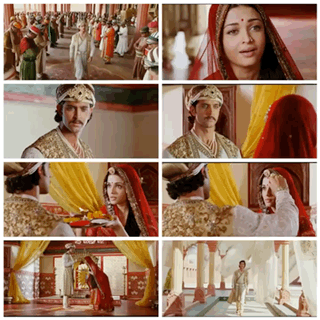
For Jalal, it is almost love at first sight. Though completely smitten by her, he knows instinctively that Jodha is going to take more time, no matter how impressed she is with him. In the next few minutes, Ashutosh shows Jalal and Jodha gradually treading the first steps of love with Javed Ali's mellifluous voice ringing in the background. 'Kehne ko jashn-e-bahara hai, ishq ye dekh ke hairaan hai, phool se khushboo khafa khafa hai gulshan mein, chupa hai koi ranj fiza ki chilman mein'. When the inimitable Javed Akhtar is in charge of lyrics, songs get transformed into dialogues and help the story to march forward. Jashn-e-bahara does just that, and does so exquisitely. It challenges the notion that romantic scenes must always entail physical intimacy, and proves that sometimes a look or a smile is worth much more. Most of the credit for this should go to Hrithik and Aishwarya who defy every existing idea about screen chemistry by making heartbeats race even through mundane acts such as walking side by side while glancing furtively at each other, or smiling in embarrassment as they sit miles apart in a garden. Who says old-fashioned romance is always boring? When two individuals are able to set silver-screens ablaze by just standing together in one frame, every trivial action becomes exciting.
Scattered in between their light-hearted romantic moments during this prolonged sequence are two ‘more important’ ones. The first one depicts Jalal in an angry mood as he admonishes Maham Anga’s son Adham Khan when the latter dares to insult Jodha; as his awe-inspiring authoritative ‘Khabardar Adham, Rajkumari ka naam adab se lo. Ye na bhulo ki ab wo Malika- e- Hindustaan hain’ echoes through the silent night and reaches Jodha, she understands the extent of his respect for her and there is an expression of happy pride on her countenance. The second is probably everyone’s guilty pleasure and inspired multiple ‘tele-serial adaptations’ back in the day; while Jalal practices moves with the sword bare-bodied, Jodha suddenly catches sight of his chiselled body and cannot stop staring. In a brilliant directorial move, Ashutosh makes her put the plate of worship down so that she can actually concentrate on the view better 😂😁🤩🤩. Aishwarya is terrific here, portraying Jodha’s attraction to her husband perfectly although in an extremely nuanced manner. Of course when the man in question is Hrithik Roshan, it helps. Jalal is shrewd enough to notice his ‘wifey dearest’ and catches her off guard by turning around suddenly after which the poor girl hastily draws the curtains. Hrithik’s mischievious look is a treat to eyes! But seriously, how mean of him to intrude upon his wife’s private moment of ‘adoring her husband’ that way?🤪🤪

Being one of the best directors in the industry, Ashutosh Gowarikar ensures that his film contains the right mix of romance and drama. The first instance of drama in the movie since the wedding is provided by Maham Anga, Jalal’s ‘Badi Ammi’ (played by the exceptional Ila Urun) a politically shrewd woman, whose possessiveness for her foster son and displeasure at the advent of a strong-willed intelligent Rajput princess into the fort of Agra makes her vindictive towards the said person. When Jodha decides to prepare authentic Rajput food herself after Jalal orders a ‘Rajputi Daawat’ on the day of ‘Peer’ in her honour, Maham Anga spews venom at her through harsh words and accuses her of trying to establish control over the kitchen, and eventually Jalal himself. Jodha, although shocked, gives her befitting replies, and ultimately completes the entire cooking by herself. The scene that follows could easily have been a disaster if it had been handled by an ordinary director; it could have been an excruciatingly slow and boring sequence testing the patience of the audience. The fact that it is one of the most interesting parts of the entire film is a measure of Ashutosh Gowarikar’s genius. Substantial credit must also be given to the actors including supporting ones without whom Ashutosh might not have been able to produce the desired outcome in this scene ultimately. However, this scene belongs to Aishwarya Rai Bachchan. Her shock at being insulted by Maham Anga when she asks her to taste the food before serving it to the emperor, rage as she turns to her husband for support, and suppressed anger as well as sadness when she realizes that there is no way out are nothing short of mesmerizing. Her genuine happiness when Jalal decides to have food from the same plate she has eaten and her sly look towards Maham Anga are a sight to behold. Truly, Aishwarya is probably one of the most underrated actresses in our industry; she is fantastic but does not always get the due credit for it. Most of the time, it is her beauty and personality that gets talked about. Nevertheless, she is a terrific actress too and we sincerely hope people acknowledge that more often. Hrithik supports her fascinatingly throughout the scene, his eyes showing anger, helplessness and embarrassment at his wife’s insult flawlessly. It is the mark of a great actor to allow his co-actors to soar when the scene requires so. In an old interview, while explaining why Aishwarya was his favourite co-star, Hrithik said that they had very similar working styles which made them more compatible with each other; according to him, both of them were more concerned with the larger picture, and did not care if they were being given importance in every frame or not. This particular scene is the perfect example of that working style he was talking about.

The ‘Rajputi Dawat’ sequence changes something between Jodha and Akbar; they have managed to cross that initial threshold of hesitation towards each other. However, just when they are gradually coming closer, circumstances and people pull them apart. When Adham Khan murders one of Jalal’s most trustworthy ministers, Shamsuddin-Muhammad-Atgah-Khan, and intrudes into the emperor’s personal premises with a sword, the latter tackles him and orders royal guards to throw the traitor with his head downwards into the ground below. When he is only half dead after the first fall, Jalal, showing his cruel side, orders his soldiers to bring Adham up to the roof so that they can throw him down again. Future generations will remember Hrithik for this scene among many; he is spectacular here with a stance that is completely majestic and a face that exudes rage and grief in equal measure. He was actually able to generate tangible fear amongst the audience back when the film had released; we still remember the collective gasp at the theatre during this scene. This is also the first time Jodha gets acquainted with Jalal’s darker side. Until this moment, she had known him as a gentle, understanding young man; now she sees him as capable of being cruel to someone. Aishwarya’s portrayal of fear is spot on and subtle with no melodrama whatsoever, for which the director also deserves praise.
The next scene had actually been deleted from the movie to manage its length but we genuinely feel it should have been included due to its significance. Horrified at Jalal’s action, Jodha confronts him in a terrific angsty sequence only to realize that Jalal is mourning the loss of a father figure in Shamsuddin-Muhammad-Atgah-Khan. Hrithik is superlative as Jalal breaks down and confesses to his wife about being orphaned again. This is the most tender moment both have yet experienced, and that realization is clearly etched upon Jodha’s face, who gives her heart-broken husband sound advice. She understands why he killed Adham, but asks him to apologize in front of Maham Anga, despite all the troubles the latter has created for her. We surely would not have minded sitting in the theatre for a few extra minutes to watch this brilliant scene Mr. Gowarikar!
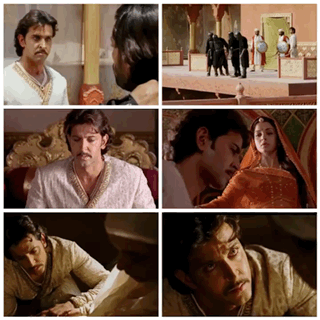
The scene wherein Jalal explains his behaviour to Maham Anga is one of the most important sequences in the film for multiple reasons. Firstly, the acting is phenomenal; emotions have always been Hrithik’s forte and what do we say about Ila Urun? We are probably not qualified enough. So, its better to just bow our heads in respect and keep quiet. Second, this is when Maham Anga is able to instigate Jalal against Jodha by feeding him false information. She shows him a container of poison that her spy had extracted from Jodha’s personal belongings earlier and lies that his wife may be planning to harm him. In reality, Jodha’s mother had given her the poison so that she could kill herself if she feared of being dishonoured by her husband after the marriage. Maham Anga also misleads him by talking about a letter that Jodha has written to Rajkumar Ratan Singh, the Rajput prince, she had been betrothed to since her childhood. This letter had actually been written by Jodha to her cousin Sujamal, who had left Amer after being denied the throne. In the letter, Jodha had requested him to rescue her from being married off to the Mughal emperor. However, she had never sent it. After finding it in Jodha’s room, Maham Anga sends it to Sujamal, to take advantage of the situation and create a rift between Jalal and his wife. Unfortunately, this diabolical ploy works because of Jalal’s blind trust in his ‘Badi Ammi’. Upon receiving the letter, Sujamal believes it to be genuine, and goes to the Agra fort at night without caring about the risk. Jodha comes out to meet him, surprised at this sudden visit, but assures him that she is happy with Jalal. To her misfortune, her husband, who has never seen Sujamal or Ratan Singh before believes the intruder to be the latter and sends soldiers to capture him. Sujamal escapes, but only after thinking that Jodha deliberately called him there to be arrested. Meanwhile, Jalal accuses her of plotting with Ratan Singh behind his back. Outraged and shocked at this humiliation, Jodha tells him that Maham Anga is the one who has caused this entire misunderstanding. When Jalal refuses to believe her, she asks what punishment he has in mind. And, he tells her to go back to her parental house! Jodha naturally feels terribly insulted at his decision, and decides to leave him and protect her self-respect! This is a wonderfully executed sequence with the two leads reacting to each other masterfully, and turning it into one of the best angsty interactions ever. This was also the moment that Ashutosh chose as the point of intermission, a sound decision obviously because to be very honest, by this time the audience was indeed in need of some food and drinks 😄😄. On a serious note, this was a watershed moment in the lives of our two lead characters, and a perfect opportunity to take a break and come back refreshed.
Any analysis of Gowarikar’s Jodha Akbar is bound to be elaborate simply because it is impossible to designate any scene from the film as unimportant or bad. It is not for nothing that we termed this film a masterpiece at the beginning of this blog. Every second of it is still a pleasure to the senses and deserves mention. However, for the purpose of your sanity and ours (not to mention the time constraint), it is vital that we take an ‘interval’ too, and analyse the second part of the movie in a separate blog. Don’t worry, we will not take too long. So au revoir as the French say ; hopefully you will bestow your good wishes upon us once again like you have till now.❤️❤️
16 notes
·
View notes
Text
Flower of the Netherworld Event

The first big event of 2021! It is 1-2 week long Onmyoji Guardian type event that coincides with the release of SP Higanbana and it consists of 3 main parts; Mundane Dream, Withering Dream and Riverside Tourney. There is also a puzzle, but it's something you should be able to complete just by participating in the event everyday.
Mundane Dream
Progress through multiple stages by using hanafuda cards to move across tiles. As you progress through each stage, Kamaitachi will trail behind you with the intent of getting ahead of you and steal tile rewards. Every time Kamai moves you'll get some event currency. If they do happen to get ahead of you and you go past them, you will be forced to fight to a boss consisting of 4 Kamai. When you start reaching some of the higher stages (~20), Kamai will lot more and it’ll be harder to catch up to them.
Each day you start with 25 cards and you can get 5 more by completely your dailies or by buying 25 for 5-10 jade per card from the exchange shop. You'll also start each day with 3 special cards that let you choose how many spaces you want to move to, 3 more can also be bought for 15 jade per card from the exchange shop. Special cards can be used a max of 6 times per day. Both types of cards only let you move across a max of 3 tiles. If you "roll" the same number 2-3 times, you'll move across twice as many tiles (eg; roll 2 twice, move 4 tiles).
At the start of each board, you choose what type of bonus rewards you’ll get from tiles - exp, gold, evo materials or souls. For the first board, random souls will be selected for you. On auto the same bonus reward type will be selected for you.
These are the types of tiles you can land on;
Bosses: Costs 3 AP to do, can be done solo or co-op, has no time limit but there is a timer. Like Senhime's event, every time you defeat a boss within 40 seconds a new stage of a higher difficulty will be unlocked, there are 10 stage in total. Only stage 5 can be unlocked on day 1, stage 8 on day 2 and stage 10 on day 3. Stages are shared with all bosses and with Withering Dream. The higher the stage, the better the rewards.
Tiles with a red aura on them have SSR/SP bosses that the give better rewards.
Quizzes: The questions are the exact same the Demon Encounter quizzes. On auto only correct answers are selected. If you answer manually and get it wrong, you'll be given the option to fight a boss for the same rewards as if you answered correctly.
Reward Boxes: Includes event currency, Gashadokuro Tefuda (wallet/card holder looking thing), and a few item/s of your selected bonus reward type.
Move Forward: Move forward 1-3 tiles.
Ink Drawing: Try your best to trace the shape shown to you, then you'll get a letter rank depending on how well you did along with some event currency. If you choose to not trace the shape (ie; try to exit the activity), you'll have to fight boss instead and will get event currency for B rank. On auto you'll get rewards for A rank.
Mystery Pouch: Can buy 1 of 3 items for 50 jade. The items are a reward box with 50 AP and 100000 gold in it, bonus rewards for your next 3 turns or 4 special cards. Buying the special cards increases the max use limit for the day by 4. On auto no purchase will be made.
Near some certain tiles there will be flaming butterflies, going past them unlocks short story dialogue that can be read by clicking the unlabelled lantern in the bottom left of the page.
Clearing a stage grants you a luxurious reward box with event currency, tefuda, 2-3 butterflies, and a large batch of your selected bonus reward type. If you selected souls, you'll get 2-4 rows of mostly 5* souls and a few 6* souls.
Loyal Blade
Before challenging bosses, you may notice a sword icon for Loyal Blade buffs above the solo and co-op buttons. Loyal Blades are obtained by buying them with 120 tefuda per 1 from the exchange shop. The buff effects are;
10: Excess crit is converted into crit DMG.
30: Start battle with 8 onibi.
50: When attacking, ignore 30% defense.
80: Enemies gain 50% increased damage received.
They also provide 1% crit DMG and ATK per 1 blade, 1 SPD per 2 blades and ~1% crit per 3-4 blades.
Withering Dream
This is the same as Mundane Dream but with a twist. Requires a special pass to do, it is solo only, there is only 1 stage and there are 15 cards (12 normal and 3 special) used here. The cards are separate to the one used for Mundane Dream. Your goal is reach the boss at the end by using as few cards as possible so you can have extra time to fight it. There is also ranking, but there are no rewards. This part of the event cannot be done on auto.
The only tiles here are rewards boxes and mostly SR/SSR/SP bosses. As you pass certain tiles, there will be spider lilies with question marks on them. Going past them lets you pick 1 bonus effect out of a random selection of 3. The end boss is Gashadokuro and endless waves of summoned skeleton soldiers, you are not expected to defeat this boss. By default you have 3 minutes to fight it, for every unused card you get an extra 30 seconds. Rewards obtained from all the tiles are given out after you are done with Gashadokuro.
Recommended bonus effects to get are:
Deal 30% ST/random target splash damage
Deal indirect splash damage (cannot exceed 100% of own attack)
Gain 30% to deal double crits
Increased ATK by 2000 and crit by 20% + excess crit is converted into crit DMG
Increased crit DMG by 30%
Gain 30% reduced SPD for 50% increased damage
Attacks ignore 200 DEF
Additional souls sets like kyoukotsu, seductress, watcher and/or shadow
Pretty much anything that helps you deal more damage is recommended.
Riverside Tourney
This is a 16 person draft PVP tournament. Costs 1 scroll to join, scrolls can be bought for 50 jade per 1 from the exchange shop. There's no penalty for quitting after joining. For the first match of a tournament you draft pick 5 random shiki and 1 bonus effect. If you win you can pick one of your opponents shiki and your opponents bonus effect. Then for every match afterwards, you can draft pick from your initial 5 shiki and bonus effect + additional shiki and bonus effects obtained from won matches.
Ranking rewards include;
Rank 1: 66666 event currency, 20 gold orochi scales, 100 AP
Rank 2: 55555 event currency, 10 gold orochi scales, 70 AP
Rank 3: 36666 event currency, 8 gold orochi scales, 60 AP
Rank 4: 33333 event currency, 8 gold orochi scales, 50 AP
Rank 5: 26000 event currency, 5 gold orochi scales, 25 AP
Rank 6: 24000 event currency, 5 gold orochi scales, 20 AP
Rank 7: 22000 event currency, 4 gold orochi scales, 18 AP
Rank 8: 20000 event currency, 2 gold orochi scales, 15 AP
Ranks 9-16: 8000 event currency, 8 orochi scales, 5 AP
Rewards for rank 9-16 are all the same. Rewards are immediately obtained when the tournament is over. If you quit after joining a tournament you'll receive the rewards for whatever rank you would've had. So if you quit immediately you'll get the rank 9-16 rewards.
Like the Tesso draft betting in Senhime’s event, there are also extra rewards for getting 1st rank 3-6-9 etc consecutive times.
Traces of a Lost Butterfly
Collect butterflies by clearing stages of Mundane Dream to complete a puzzle. Max of 5 butterflies can be obtained per day. Submitting them grants random rewards and submitting 5 unlocks some short story dialogue. The reward for completing the puzzle is a loading screen illustration.
Exchange Shop
The shop is split into 3 tabs. Tab 2 and 3 can only be unlocked by clearing stages 7 and 14 of Mundane Dream. Notable rewards for each tab include:
Tab 1: Event items (cards, Withered Dream passes, Loyal Blades, tourney scrolls, butterflies), special kekkai/realm cards, skin tickets, gold orochi scales, 3* white daruma, 1 blue summon ticket, soul boost, gold and AP.
Tab 2: Loading screen illustration, 6* transfer ticket, special kekkai/realm cards, skin tickets, orochi scales, demon souls, 4* white daruma, gold and AP.
Tab 3: Event frame, Higanbana* skin, random SSR/SP, event packs, 1 blue summon ticket, 50 jade, black daruma, 5* white daruma, soul boost, gold and AP.
Note: The skin available in tab 3 is the Damsel of Dusk skin. For JP/TW and GL, it might be changed to something else.
Each of the 3 event packs can be bought 99 times. The type of items that can be obtained from them are;
Pack 1: 6* souls, EXP souls, orochi scales, demon souls, totem zone tickets, kekkai/realm medal etc.
Pack 2: daruma, daruma shards, realm cards, bio affection items, soul and evo buffs, AP, etc.
Pack 3: R-SSR shikigami shards, gold and EXP buffs, etc.
Recommended Teams
Mundane Dream & Withering Dream

First team is a general one suited for bosses with minions.
The second team is for bosses with no minions. Should use Kagura and target SP Tama with Orochi/Youkinshi. Who you use with with SP Tama doesn't really matter, they just need be good at dealing ST damage like Takiyasha and her ST form of her special attack.
After getting some Loyal Blade buffs, both teams should be capable of defeating bosses with 40 seconds.
Withering Dream: Gashadokuro Boss

Should try to change your team to suit whatever bonus effects you chose, especially if you use the Kinnara team.
For the free space you could use a 2nd Kinnara or SP Tama if you chose ST splash damage, or use just Youkinshi/Maestro to give Kinnara move turns instead. Could use Ushi if you chose increased transferred damage. If you couldn't get any splash bonus effects, then you could use any AOE multi-hit shiki (Suzuka, Ootengu, Ryoumen, Ubume, etc).
You could also just stick with the standard Kinnara team and use SP Kiyo or SR Kiyo. Sasori isn't 100% needed either, so she can potentially be swapped out with someone else.
22 notes
·
View notes
Text
How Alias Anticipated Modern Superhero Storytelling
https://ift.tt/eA8V8J
J.J. Abrams’ spy drama Alias, which turns 20 this week, was a lot of things: high-octane action-adventure series, twentysomethings relationship drama, occasional National Treasure homage. It was also, surprisingly, a spiritual predecessor to today’s hyper-saturated superhero movie and TV universes: A preternaturally gifted fighter, Sydney Bristow (Jennifer Garner) inhabits comic-book-esque alter egos to infiltrate secret missions related to ancient artifacts and promised immortality, all while ensuring that her nearest and dearest don’t know how many times she’s saved the world—or which side she’s really on.
Like the series’ MacGuffin-generating Nostradamus figure Milo Rambaldi, Alias has proven to be somewhat prophetic itself about what makes for the kinds of superhero stories that land today. With some 20th-anniversary hindsight, let’s look back at what made Sydney’s story so super and what lessons Abrams’ ridiculous(ly fun) series can still impart to the current crop of superhero sagas.
The Secret Identity as Kiss of Death
The highest priority that spies and superheroes share is that they cannot get made—that is, have their identity as a larger-than-life individual linked to their “normal” selves. They must always keep their personal and professional personas separate, lest they risk losing the people who know both sides of them. Alias establishes this difficult lesson in the first half hour of the pilot, when Sydney reveals her true work (she thinks SD-6 is just a covert branch of the CIA) to doctor fiancé Danny, only for him to blab about it later and get bloodily taken out in their bathtub. It’s the first time that SD-6 treats its sweet protégée harshly, making clear the consequences of her actions should she open up to anyone else in her life. And then she defects to the CIA, which will be a death sentence for her if SD-6 ever finds out.
Yet beyond the specter of grisly assassination, what the series really digs into is Syd’s growing ethical dilemma about being a double agent where it concerns the actually good people at SD-6, primarily her longtime partner Dixon (Carl Lumbly) and sweetly awkward Q stand-in Marshall (Kevin Weisman). It would be too easy if the series were only about her getting long-game revenge on SD-6 director Arvin Sloane (Ron Rifkin); the real conflict comes from Sydney lying to Dixon’s face on every stakeout, knowing that he still thinks he’s working for the good guys and she can’t ruin that fantasy for him without potentially turning him into collateral damage.
Similarly, the moments in which Sydney’s two (or three) lives begin to collide have other heartbreaking consequences: While the scene in which her best friend Will (Bradley Cooper cast as the friendzoned buddy, amazing) gets kidnapped and sees Syd saving him, is one of the decade’s best laugh-out-loud moments, it also leads to Will going into the Witness Protection Program. His life ends, in a sense, because Sydney couldn’t keep everything compartmentalized. And we haven’t even gotten to the awful fate that befalls her best friend Francie (Merrin Dungey)…
What Alias Predicted: The beating heart (or arc reactor) of many a superhero story is this tension between selves—which means that the big reveal of a secret identity has to be carefully timed and deliberately presented. It’s as emotional as Peter Parker’s (Tobey Maguire) mask getting ripped away when he saves the subway car of people in Sam Raimi’s Spider-Man 2, as big as Spider-Man: Far From Home doxxing that Peter Parker (Tom Holland) in a commentary on fake news, or as pure and simple as Tony Stark (Robert Downey, Jr.) outing himself as Iron Man in the very first installment of the MCU. You cannot unring that bell, so it better be a memorable moment.
What Superhero Stories Can Still Learn: Rev the secret identity stakes back up! Captain America: Civil War ably took on the game-changing Marvel Comics arc of the same name by having heroes collectively unmask, and movies like Spider-Man: Far From Home are still playing out those ramifications. But mostly we see the dangerous ramifications of heroes doxxing themselves, without really digging into the strain for heroes to constantly have to lie about the things that truly matter to them.
cnx.cmd.push(function() { cnx({ playerId: "106e33c0-3911-473c-b599-b1426db57530", }).render("0270c398a82f44f49c23c16122516796"); });
Campy Disguises and Clever Aliases
If you’ve watched Alias or were even vaguely aware of it, no doubt the first thing you envision is Sydney in black leather and bright red hair, a.k.a. her iconic look from the pilot. Her non-SD-6-sanctioned, under-the-radar disguise (impersonating Will’s sister) displays her ingenuity and establishes the series’ brand: attention-grabbing hair paired with increasingly ridiculous outfits, from chain mail waitress ensembles to rubber dresses. She’s played punks, rich bimbos, alluring businesswomen, escorts, and all manner of female personas upon which her marks would project their assumptions—all of which belied her true strength and cunning.
Even when future episodes riffed on the color wheel with teal, magenta, purple, and good old-fashioned blonde wigs, it was still within a clear spectrum established on that pivotal mission, when she channels a silly girl who cares more about the color of her hair than her safety, only to pin her torturer with the same chair to which she’s bound.
What Alias Predicted: I would hazard a guess that Natasha Romanoff’s first appearance in 2012’s The Avengers—a seemingly helpless redhead tied to a chair, about to be nastily interrogated—was a nod toward Sydney’s triumphant pilot mission. What’s more, despite the first ten years of the MCU leaning toward sleek costumes, later phases (like WandaVision‘s cheeky Halloween callbacks) have realized that they can embrace the bold colors and campy designs of the comic-book source material.
What Superhero Stories Can Still Learn: Better to lean into the bold colors and campy designs of the comic-book source material than to go for more sleek and cool. WandaVision did this, albeit cheekily and using the excuse of Halloween, but the nod toward Scarlet Witch’s original outfit was well received. Because any superhero can look cool in leather, but only the standouts can rock color.
Rambaldi Artifacts, Immortality, and Clones
While replicating the romantic dramas of Felicity, Abrams was also playing with early iterations of his signature “puzzle box” narrative style: The pilot has Sydney chasing after the mysterious Mueller device, which turns out to be… a floating red ball… which bursts into water the moment she tries to remove it. That head-scratcher of a device is only one of many inventions belonging to Milo Rambaldi, a fictional Renaissance-era philosopher whose sketches and writings all pointed toward the ultimate endgame: immortality. You know, just normal spy thriller things.
The series saw Sydney and co. chasing after all manner of Rambaldi MacGuffins, from a clock to a kaleidoscope to a music box to flowers that either demonstrated proof of eternal life (by never wilting) or amped up human aggression. Through all of this, it becomes clear that Sloane helped found SD-6 in order to collect all of Rambaldi’s artifacts and capture immortality for himself—even and especially at the cost of people like his daughter, Sydney’s half-sister Nadia Santos (Mía Maestro).
Before we get more into Rambaldi’s prophecies about the sisters, we can’t forget the parallel fever dream of the series: clones! Or, rather, secret agents genetically modified to look like anyone—which means everyone is a suspect. This constant paranoia quickly got out of hand on the series, but its first reveal was perfect TV drama: There’s not an Alias fan who doesn’t remember “Francie doesn’t like coffee ice cream” and the complete devastation that followed—the knock-down, drag-out fight that destroyed Sydney’s apartment just as badly as Danny’s death, but also Sydney’s heartbreak upon realizing that her best friend was already long dead.
What Alias Predicted: The Infinity Stones themselves are less interesting than in various superheroes’ personal connections to them: Loki (Tom Hiddleston) tempted by the tesseract in Thor: Ragnarok; Star Lord (Chris Pratt) and the Guardians of the Galaxy channeling their friendship to withstand the effects of the Power Stone; Wanda Maximoff’s (Elizabeth Olsen) stages of grief as she copes with trying to keep the memory of Vision (Paul Bettany) alive even without the Mind Stone. In short: grounding the most out-there plotlines in the personal ensures they will always land.
What Superhero Stories Can Still Learn: Ground the most bonkers of plotlines in the personal, and they’ll always land.
The Chosen One and the Passenger
This is when the Rambaldi business started getting less National Treasure levels of charming and more outright weird. Turns out the team wasn’t just recovering a treasure trove of artifacts, but also Rambaldi’s prophetic writings—including the mysterious “Page 47,” which featured a drawing of a woman known as the Chosen One… who bears quite the resemblance to Sydney herself. That would be easy enough to dismiss as a strange doppelgänger coincidence, but then comes the reveal of “Project Christmas”: When Syd discovers that she didn’t just stumble into the spy life on her own, but was actually trained as a sleeper agent from childhood, it only amplifies her fears that she has no true agency over her life.
Further Rambaldi writings center Sydney and Nadia into predestined roles as the Chosen One and the Passenger: supposed foes who are fated to clash, with one dying. Nadia getting injected with “Rambaldi fluid” in order to tap directly into the long-dead man’s consciousness (contained within another artifact known as the Sphere of Life) only earns her some nasty apocalyptic visions. But despite their genuine friendship that comes from bonding over their fucked-up childhoods, Sydney and Nadia are forced into that preordained confrontation when the latter is injected with a compound that reduces her to a mindless killing machine… all while a giant red ball is hovering over a city in Russia, because why not. Even after Nadia dies, and is brought back to life, then dies again, with her ghost haunting Sloane as he finally attains immortality, she remains a presence on the series.
There are certainly echoes to Black Widow and how it handles Natasha and adoptive sister Yelena’s (Florence Pugh) strained reconciliation after the older sister got out of the Red Room while the younger was still caught in its web. Their bickering banter about vests and poses, their differing memories of their false childhood, and their respective feelings of abandonment are what elevated Black Widow’s standalone outing—and made it even more tragic, on multiple levels, that this was the only time we would see the two of them in a movie together.
What Alias Predicted: Sister stories are gold! The Rambaldi storylines would mean nothing if they didn’t hinge on a tragically preordained confrontation, just as the MCU’s Red Room depiction seemed overdone until it was presented within the context of multiple generations’ differing experiences with its bloody legacy.
What Superhero Stories Can Still Learn: More stories about sisters! With Nat dead not long after she and Yelena had just started to bond again, it’s vital that Yelena’s future MCU appearances show her still grappling with the little time they got together.
After all, the best superhero stories are the ones that can feel just as fresh now as they did 20 years ago.
Alias is currently streaming on Amazon Prime Video.
The post How Alias Anticipated Modern Superhero Storytelling appeared first on Den of Geek.
from Den of Geek https://ift.tt/3ih3u0c
2 notes
·
View notes
Text
An Unexpected Turn of Events
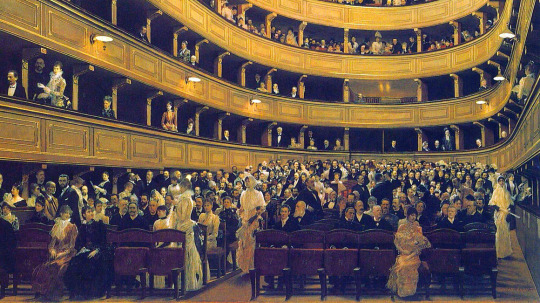
Hiya, folks! So, as previously announced, the wlw writing project continues after a break with a miniseries set back in Vienna, one of the iconic capitals of opera at the time of Mozart. An emerging singer gets the chance to be an understudy in the latest Mozart’s discussed opera Le Nozze di Figaro (The Marriage of Figaro), that premiered at the Burgtheater in Vienna on 1 May 1786, w and play the pants role of the page Cherubino. Preparing for the role doesn’t quite go as planned… .
Tagging: @scottishqueer
Previous chapter: The Understudy
Hope you enjoy it: if you do, please consider spreading the word!
____________________
A couple of days later I go back to Melchiorri for another session as planned. He is inflexible that I allow my voice to rest at least one day before practising again not to damage it. As I observe the streets of Vienna passing by from my carriage, I wonder if the little fugitive will visit us today too and a tiny smile crosses my lips. I should be bothered by such unprofessionalism but surprisingly I enjoyed the interruption. A private comedic enteract. It also reminded me the maestro is human: I stole a glance of the domestic, family life people like me is generally unfamiliar with. I don't plan to marry anytime soon honestly if I can avoid it, despite what my Aunt claims. I owe her and my uncle, the wealthy side of my family, everything. She brought me away from the small town by the Alps I lived with Mom, Dad and Hans, my little brother in a wooden cottage by a stream. We weren't indigents, we owned a small typography in town that mainly served the local journal of the valley and well, the church crafting the prayer books you would find on the bench every day at mass. We weren't rich with either: you don't exactly became high socialite with so little. Hans is now running the typography as my father's eyes are not the ones he used to have since he got sick. I don't envy my poor brother; I am glad I got my way out of that life. I am eternally grateful to Auntie Helga for insisting to drag me to Graz and deciding to turn me into a star of the opera after hearing me perform a solo in the church choir during one of her - not so frequent, actually - visits.
Auntie built her fortune over a good marriage with a promising young lawyer who couldn't resist her charm and eventually allowed her to live in sober luxury and even be invited to court. But that seemed to be her sole aspiration in life: she left the small town and never looked back. I am an opera singer, I want more. My career comes first and I have yet to meet a worthy match honestly. And no, I don't want to be a puppet, a doll to a man who will eventually ask me to leave the stage and my beloved arias to look after a child or be a proper wife, whatever it means. So, no, thanks, I chuckle in my head while taking the hand the driver offer me to get off the carriage. When I knock at the door, I am considering that maybe Herr Giorgio is not that bad, even if I didn't like the way he addressed the maid and the poor naughty boy. Nor the lusty looks he throws me. The maid welcomes me with a smile and a little reverence. Good girl, probably she expects me to chastise her too. As if I had any intention to do so! She takes my fur and quickly disappear into the wardrobe room before walking back towardsme. I thank her for her zeal but I know the way to the music room, the maestro is surely waiting for me, I say. I start walking but what she says next makes me freeze, confused. "Actually, Miss...the master is not here today. I'm very sorry. His wife is waiting for you in the tea room". What? That...that must be a joke. The maestro hired to prepare me last minute disappears before the official rehearsals. I turn and throw a bad look at the poor maid, who doesn't deserve it in the least. She's just a messenger, her eyes beg before lowering them to her feet. She's right, my anger is all for Mister Melchiorri. What do I do now? "Whatever, lead the way then" I exclaim, following her. "I can't wait to hear what the fair lady has to say about this". My voice is cold, sardonic; the girl doesn't say a single word while we walk in the opposite direction than my usual route in the house. She's certainly too afraid to dare say a thing. When we finally arrive to the right room, she knocks politely at the door and steps in when a female voice comes from the inside. She bows her head and announces my presence before disappearing back down the corridor. She stops only to let the door open for me. I let out an annoyed sigh and enter. The room is significantly different from the maestro's studio. No instruments, only paintings at the walls and fresh flowers on the little tables around the room. The perfume is delicate and inebriating: are they orchids, I wonder? A neat wooden library holds the place of honour on the main wall, opposite the fireplace and framed by windows that fills the whole room by natural light, even if the sun doesn't shine today: it will probably rain soon. Letting my eyes wonder outside I spot green and a carousel: I didn't realise we were so close to a park! Unlike the music room, here even if the furniture, the velvet armchairs, the Persian rugs, every decor are certainly expensive, the atmosphere is surprisingly...cozy, an adjective I would have never thought of associated with Melchiorri's place. It's almost inviting, calming? "Miss Bauer, I am so incredibly sorry for the the latest developments and all the trouble they must bring on you...but please, take a seat! Franziska will be back soon with fresh tea". I turn to see a woman gesturing me to join her by the fireplace. Her German has a thick Italian accent which gives her "a bit of exotic" as they say at court. She doesn't wear a wig, her long raven hair are done up in an elaborate grateful chignon and two curly strands frame her visage. She reminds me one of those shepherdesses portrayed in bucolic frescos at the Emperor's Palace. Her dress is not in character though: a plain, cerulean dress which is not necessarily cheap but does nothing to enhance her figure. Poor taste probably: even money can do little about it sometimes. She must be in her early thirties or so I wager and thinner than most ladies I know in her standing...I wonder why Melchiorri chose her if he's so clearly fond of female curves. Maybe it's another arranged loveless marriage. I wouldn't be surprised. I oblige and thank her politely, forgetting my anger for a moment. It surprises me, it must be a reflex, a natural response the soothing silky voice of the lady. Like the feral beasts tamed by the gentle melody of Orpheus' song, I think trying to shake away such thought. I suddenly realise that I don't know her name. Melchiorri never talked about her. But I don't want to tell her: it's not a nice thing to say to a wife, right? As if reading my thoughts, she shakes her head slightly embarassed. "I forgot my manners, didn't I?" she sighs. "You must forgive me, Miss, I do not receive many visitors lately and I've never been introduced to famous opera singers...nor any of my husband's pupils. My name is Cecilia, Cecilia Melchiorri". I feel a pang of sadness for this lady excluded from the theatre world his husband works in. I don't get why she has to be cast out like that. I've met other illustrious wives at social gatherings around Vienna or at court. I offer her my hand, gesturing no apologies are needed, and repeat her name. "Cecilia...". Sadly, I completely butcher it: I studied Italian for the opera but my Austrian tongue is still incapable to recreate the sweet sounds that comes so natural to her. It must not be the first time because her lips curl in a quick understanding smile. "You can call me Lia, if it's easier for you. My family used to call me so". Lia...what a pretty little name. I smile, grateful. "I will then, if you don't mind...Lia. You can call me Constanze: it seems only fair". "As you wish, Miss Bauer!" she says before realising her mistake. We share an amused look, even if hers is a bit more bashful. In that moment, after another polite knock, Franziska returns with the tea and some butter biscuits. They're different from the ones Mister Melchiorri usually offers me in his studio. She's serving the tea when a familiar figure materialises on the threshold of the room at my peripheral. Lia is giving him the shoulders so she can't see him. I turn in his direction with a smirk. "I believe we've already met, right, Sir?" The two women turn at unison too and the kid childishly hides his face but doesn't move. After a moment he spies us through his fingers and retrieves his hands, smiling. Franziska puts the tray underneath her arm and tells Lia that she will bring him to his room, making the boy pout. He's quite the character. "Maybe he followed you because he just wants a biscuit" I say, my eyes wandering between them to check if I'm overstepping. "Maybe you're right...but only if he doesn't bother you" Melchiorri's wife concedes with a tired smile. I shake my head and take the decorated plate in my hands. "Would you like one?" I ask in Italian to her son, not sure if he speaks proper German. His face brightens up and he nods enthusiastically. We share a soft laugh, even the maid joins. He gets ready to speed across the room when he stops, considering. He searches his mother for approval. Lia nods, asking to behave like a good boy though. So he approaches slower than he wanted, with great effort to refrain himself, and grabs a biscuit from the plate. Before taking a generous bite, he mutters a quick thank you. "Mystery solved" I comment, placing the plate back on the table. "You must excuse him, Miss Ba- Constanze" Lia say, gently pulling him closer. "Nino is not a bad kid, just a bit of a rascal at times". "A rascal with a sweet tooth" Franziska adds and we share another laughter. "I'm so sorry he interrupted your private session the other day. Franziska had quite a fair share of work to do and I was indisposed in my room, I couldn't look after him as I usually do". I dismiss her apologies, taking a sip of tea. "But it was fun, wasn't it?" I wink at Nino who chuckles. "Yes and she sings very well, Ma" he says, turning to his mother. "Of course, I heard her too from my room" she smiles. "She's a promise of the opera, it's written on the newspapers". "Sing again?" the little boy begs, expectantly. His childish enthusiasm amuses me. "I cannot do those trills now, I need to warm up my voice first" I apologise, before winking. "Another time, I promise". Lia whispers something into his ear and he thanks me, concealing his disappointment. Crumbs are stuck on his lips and make the smile that follows a bit funnier than it was supposed to be. "Now, sweetheart, why don't you follow Franziska back to the kitchen?" She says, stroking his curls. "Take another biscuit and she will give you a glass of milk, just as you like it, huh?". She doesn't have to say it twice: while the maid gently places and arm around his shoulders, guiding him away, he takes not one but two biscuits in his hands. He throws me a conspiratorial look before chuckling. Then he turns towards Lia and stretches his neck to kiss her cheek. She caresses his face and tells him to be good with Franziska. When the two of them are out of the room, she meets my gaze again, shaking hear head. "Apologies, Miss...I sent Franziska to buy these for you this morning and he managed to put his eyes on them. He became obsessed". "Kids" I shrug, unbothered. I am pleasantly impressed that she had such a kind gesture towards me. I mean it could be a way to get on my good side because of the news she has to give me...but after all, this situation is not her fault. Her husband left her to deal with this and me all alone. She turns serious and sighs. "Anyway, have you heard of the flooding near Salzburg?". "What?". "Torrential rain lead to conspicuous floodings in the area surrounding Salzburg. I don't know if Giorgio mentioned it to you but he head there after your session for a family emergency....his brother lives there". "I'm afraid he didn't say a thing about his little journey" I say, trying my hardest not to look angered, even if I am: I would have rather be informed sooner of such details. By the look on her face I can tell she expected such an answer. "He surely thought he would be back in time today, he didn't mention staying for long. But during the night the weather deteriorated and the roads are pretty much impracticable, so to speak. We've just received a note saying he will be back as soon as travelling conditions are restored and the emergency solved. Probably a couple of days...maybe more? He must have sent you a similar one, you just missed it because you were on your way here already". "A couple of days? Maybe more?" I exclaim. That's not promising... "The rehearsals start in a week" I frown. "I still need to practise...". "You are free to do it here if you wish, Miss" she suggests, apologetic yet encouraging. "I am perfectly aware this is a hideous setback for you with such a tight schedule. You must believe me when I say I wish we never put you in this situation...if there's anything I can do, Miss, ask away. I'm not my husband but...". I consider her words for a moment. My mind runs wild to find a solution for this unexpected unfavourable circumstance. I could find another maestro maybe but how, within such a short notice and little time before official rehearsals begin? I could do it on my own but another sudden foolish idea crosses my mind. "Do you play the cello, Mrs. Lia?" I must have taken her by surprise by the look on her face. She tries to conceal it, refilling her cup. "Why, yes. My father was a musician, I took cello classes in my youth but I don't see how this-". "Excellent! Then you can take your husband's place until the he’s back" I exclaim, cutting her short. My words must come as a shock: she almost spits her tea. "Beg pardon, Miss?". "You will be my maestro, well understudy maestro for the time being" I smile, explaining. "You said yourself that you can play the cello, you can assist me as I practice". "But...but I don't have my husband expertise" she objects, at loss of words. "You heard me practicing with your husband, right? So you must know how it should sound. And that aside, you can even tell yourself if my performance is good or not: you have ears too, if I am not mistaken". She opens her mouth to say something, anything to make me change my mind and spare her such thing...but nothing comes. Her lips presses together for a moment before she places her cup back on the table. "Very well, then...if you think it would work" she smiles weakly. "Just be patient with me: I do not usually play opera arias".
11 notes
·
View notes
Link
From left: Photo by Gi Naps/Getty Images; Photo by Rose Hartman/Archive Photos/Getty Images; Photo by Victor Virgil/Gamma-Rafo via Getty Images
Today, the House of Jean Paul Gaultier is relaunching its ready-to-wear line after a hiatus of six years. It comes 16 months after fashion’s “Maestro of Mehmed”, as journalist Georgina Howell dubbed her in the early ’90s, took her final bow as the brand’s designer, implying that this iteration of its namesake. will not be designed. Instead, the reins are taken over by a dedicated team from their atelier, with help crafted from the rotating doors of some of the most independent designers working today – Palomo Spain, Ottolinger, Nix Lecourt Mansion, Alan Crosetti and Marvin M’Tumo .
Since starting his own label in 1976, Jean Paul has been instrumental in turning underwear into acceptable outerwear, making sailor fashion sexy and, more generally, paving the way for designers to experiment with diverse and unexpected castings on the runway. have been responsible for. He also dedicated an entire collection – AW97 – to the fight against racism. The collection, titled ‘Fight Racism’, featured graphic prints of young anti-fascists with slogans printed on their chests.
In fact, with such a rich history behind it, and vintage JPGs becoming increasingly collectible since the recent renaissance—partly stemming from the Kardashians’ love of all things net—more thanks to the label’s revival. Couldn’t be the right time- the line to wear from now. Although it is a well-known fact that Jean Paul himself decided to step back from the category in 2014 after a somewhat tumultuous feud with Florence Tetier (graphic designer and co-founder). November MagazineNow serving as the brand’s creative and brand director, Ghar is poised to enter the field again. in an interview with WWDJPG’s general manager, Antón Gégy, described the relaunch as an opportunity to “celebrate Jean Paul Gaultier, its values, its archives and its history”. And what better way to raise the glass to the core of fashion? Horrible Instead look at seven of the most show-stopping moments from its most iconic era, the ’90s. Long live Gaultier!
Photo by Gie Knaeps/Getty Images
Madonna’s Conical Corset from the Blonde Ambition Tour, 1990
Back in 1989, when Jean-Paul Gaultier was told by an assistant that Madonna had told the audience, she was convinced that he was playing a trick with her. They knew how obsessed he was with her, just could not do be true But she soon found herself on the phone to the original queen of pop, making a match in ’90s fashion heaven. Naturally, Madonna already knew what she wanted: to create something for her that surrounded Jean Paul’s signature masculine-feminine crossover. Inspired by his love of the late ‘queen of Paris punk’ Edwij Belmore, Jean Paul conceived a pinstripe suit – the top of ’80s manhood – and a corset with the now famous conical bra, which he designed six years ago on AW84 had started for. /85.

Photo by Victor Virgil/Gamma-Rafo via Getty Images
Eva Herzigova’s cut-out dress, 1992
Thought harnesses were a new thing on the runway? Wrong! After all, you’re not known as a fashionista Horrible Without a sprinkling of kinks here and there, as this look proves well. Presented on JPG’s AW92 runway, this dress, so slick in its fit that clothes can even put on Eva’s body, exemplifies the powerful-yet-playful take on sexuality that serves as a throughline throughout the French designer’s body of work. runs as. Styled with bicep-clad opera gloves and proudly crafting the Czech-Italian supermodel’s bust, there’s a distinctive dome-y tone at play here, though no compromise on the beauty of the silhouette or the quality of the make. It speaks to an ideological throughline that runs through Jean Paul’s work – that no matter who a woman is or wants to be, she always has the right to be chic!
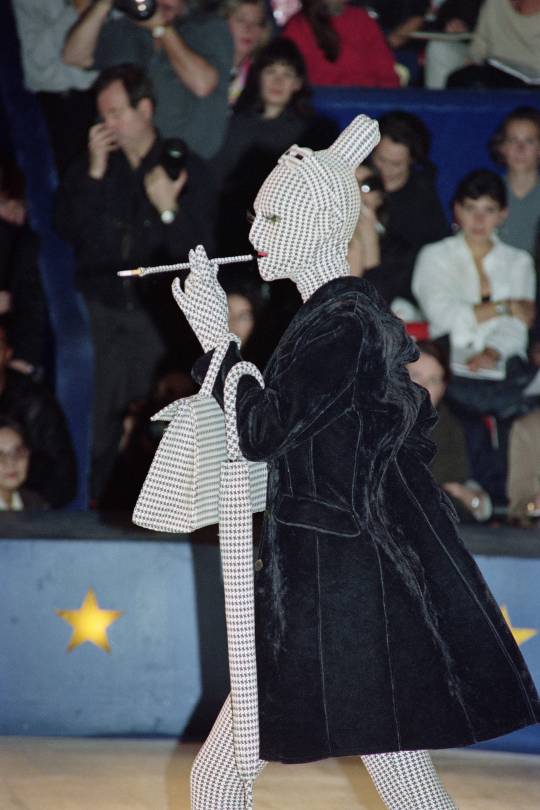
Photo by Pierre Guillaud/AFP via Getty Images
Houndstooth bodysuit inspired by Leigh Bowery, 1991
In an interview with iD in 2018, Jean Paul declared his love for the “London Way”, which means “just creating your own style, your own creativity and being free to do what you want to do”. When he took the idea back to Paris, it wasn’t very popular, but that didn’t stop him from creating his own trademark approach to design. He spent his youth in the 80s at famous London nightclubs such as Blitz and Heaven, where he met performance artist Leigh Bowery. In a nod to Bowery’s influence on fashion, Jean Paul sent down his interpretation of the Leigh Bowery Houndstooth bodysuit—which would later inspire Alexander McQueen for AW09 and Gareth Pugh for SS07.

Photo by Pierre Guillaud/AFP via Getty Images
‘Chic Rabbi’ Collection, 1993
For AW93/94, Jean Paul presented the ‘Chic Rabbi’ collection, inspired by the traditional dress of Hasidic Jews. Models in streamels and black suits danced to the sounds of a violinist who played live on the catwalk. The usual circle of supermodels was there, but Jean Paul also decided to cast someone who visually embodied the cultural context: a man with a big beard. During the ’80s and ’90s, designers were known for their casting choices, pioneering their diversity. “I’m fascinated by strong personalities, people who capture my imagination because they walk well down the street,” Gaultier explained in a 2014 interview. “Showing just one type of girl is a flaw,” he adds, “something I’ve always fought with. One kind of beauty – no. If I show a bigger girl, I’ll always show a younger girl.” will show.” It is now legend that Gaultier once posted an advertisement in a French daily newspaper release Looking for “atypical” models, saying that “facial distortions should not be avoided in application”.

Photo by Arnal/Garcia/Gama-Rafo via Getty Images
Mesh Tattoo Top, 1993
Back in 1993, the trend Declared this prestigious collection as “a startling vision of cross-cultural harmony”. While we’d be inclined to cringe at the somewhat reasonable look now that Jean Paul drove down the runway for the SS94 (which can actually be read as another nod to Leigh Bowery) it certainly Historical perspective. It also marked the debut of Jean Paul’s iconic mesh tops, which were inspired by a tattoo convention he once found himself spinning around – today, they are some of his most sought-after designs. The collection also includes heavy notes of punk, grunge, and 18th century men’s frock coats made in Jodhpur and denim in the typical JPG style. How did he ever find the place for all this?!
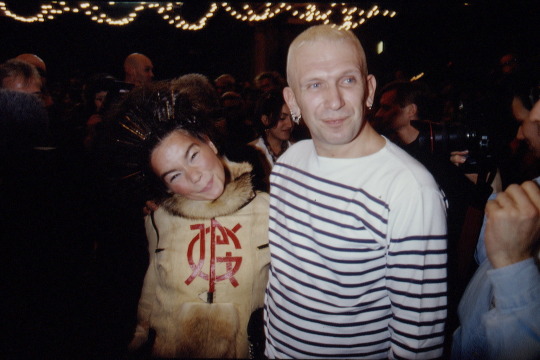
Photo by Pierre Vuthe/Sigma/Sigma via Getty Images
Björk!, 1994
Jean Paul’s celebrity friends don’t start and end with Madonna. A year after Björk’s properly titled debut solo album, First entry, Taking the music and fashion worlds by storm, she appeared on the designer’s AW94/95 show, about a magical train that stopped in a small village somewhere high in some mountains. And what, duh?! As you’d expect from JPG, the show was a mish-mash this time in terms of different styles of traditional arctic costume. The models trotted down the snow-covered runway (which almost tripped Kate Moss), decked out in a hell of a lot of fur, silk, wool, and leather.
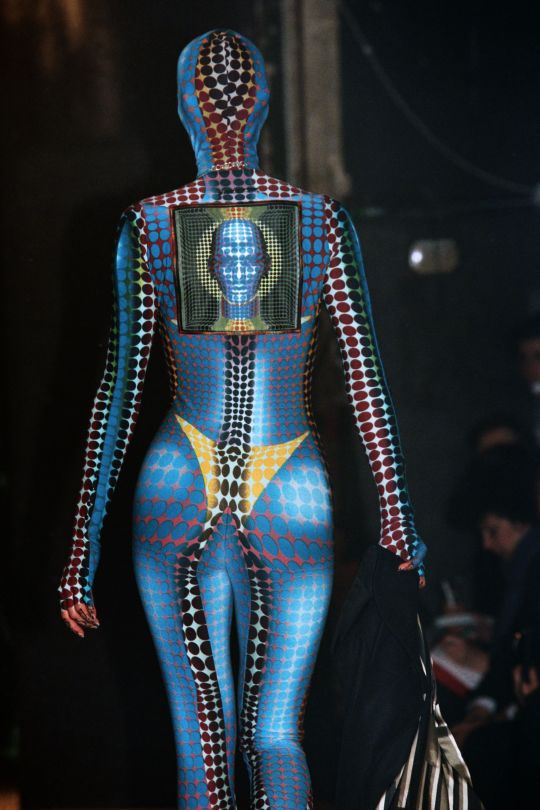
Photo by Pierre Verdi / AFP via Getty Images
Op-Art Inspired Catsuit, 1995
Two women riding a motorcycle hit them. One of them descends and climbs onto a loft at a DJ booth. Jean Paul’s AW95 ‘Mad Max’ Show Has Started. As he was in the middle of designing the costumes for Luc Besson’s famous film fifth element In which Bruce Willis and Milla Jovovich fight a mysterious cosmic force, they had science-fiction in mind, which means it was technology and cyber-heavy. The bodysuit inspired by Viktor Vasarelli’s op-art paintings became the show’s most memorable aspect—now made super collectible by Kim K and Cardi B and partly responsible for the JPG-madness we’re seeing on Depop these days. Also on the show was Carmen Dell’Orefice, who walked with a live falcon on her arm and sported ornate football armor that lit up like a circuit board. Really prestigious.
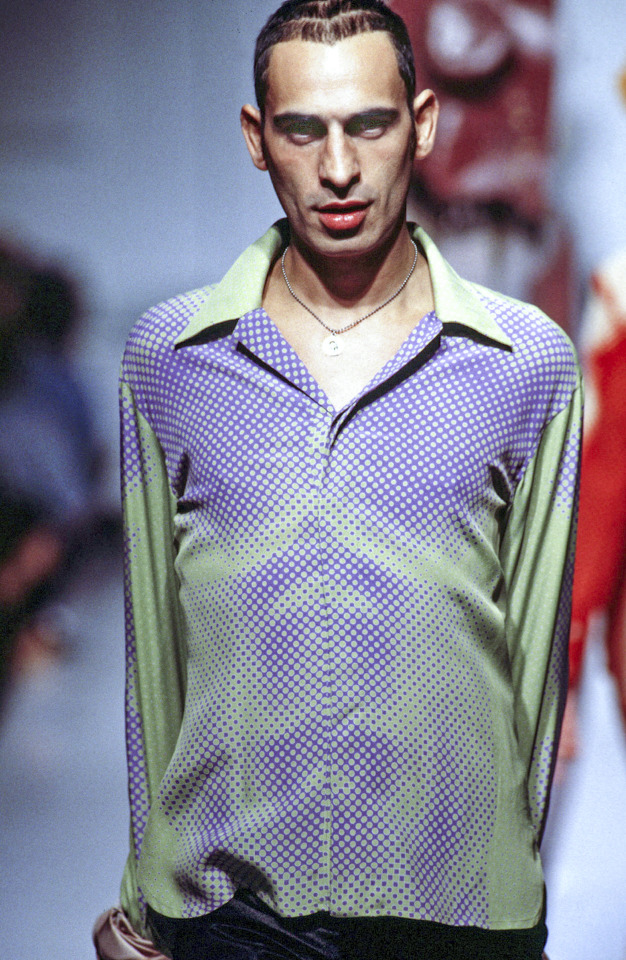
Photo by Victor Virgil/Gamma-Rafo via Getty Images
trompe l’oeil torso top, 1995
The next season, Jean Paul took his quest for sci-fi polka dots further, this time translating it into menswear. This time, however, he brought his knack for trompe l’oeil print placement to the table—skills he had previously flexed in the aforementioned Les Tautouzes, and even as early as 1992, when he sculpted the enviable Presented Printed Mesh Top with Toros. The look sported here by Tanel Bedrossiantz is perhaps a little more figurative in its approach, though no less direct is its infrared-style suggestion of what might lie beneath the longtime house muse’s button-down shirt.
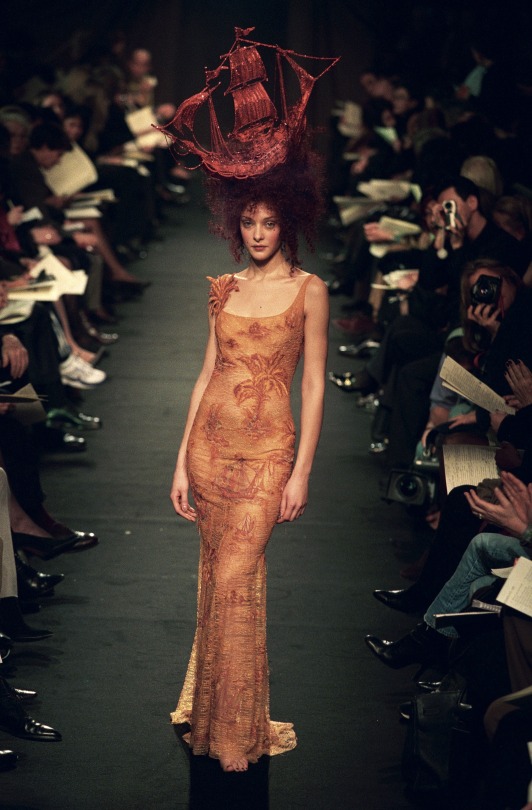
Photo by Danielle Simon/Gamma-Rafo via Getty Images
JPG Set Sale, 1998
In a promo video for JPG’s new ready-to-wear line, Bella Hadid is wearing a big red ship on her head. In case you didn’t already know, it debuted at the Haute Couture SS98 show, where it takes us back to the Age of Enlightenment. It was a time of scientific progress, the advent of modern capitalism and of course colonialism. The ‘explorers’ were sailing around the world from Europe, ‘discovering’ new lands for them – a ship serving as a nod to the continent’s shameful past. Some say, however, that it was during the Enlightenment that the fashion we know today – as a form of self-expression that can be accessed by the public – first began to emerge, making the historical period a fashion show. became an ideal subject. .
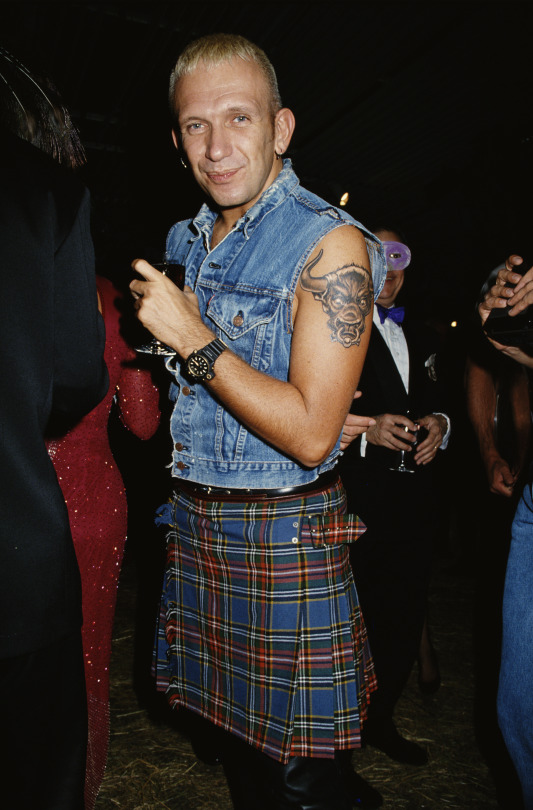
Photo by Rose Hartman / Archive Photos / Getty Images
Man Himself!, 1992
Sure enough, to write a list of Jean Paul Gaultier’s most iconic looks from his most iconic decade, and not for the man himself. Indeed, as Florence Tetier spoke to her before the label’s launch, “Everybody knows who she is!” whether it’s his striped Whether paired with a pleated black skirt or, as seen here, a denim vest and a punkish tartan kilt, JPG’s personal style has made her one of the most instantly recognizable designers of our time. Plus, there’s a direct connection between what she wore and what we then saw on the runway. While we may have never seen a proper, French Navy-standard Sailor From the designer, “he’s done a lot of stripes and nautical-inspired pieces,” notes Florence. “It’s really nice to see the link between the way he dresses and the way he designs.” we love you, Jean Paul! Follow iD on Instagram and TikTok for more fashion.
.
The post Jean Paul Gaultier’s most iconic 90s moments appeared first on Spicy Celebrity News.
5 notes
·
View notes
Text
Discovering the Best Choreographers in Mumbai: Masters of Dance and Movement
Mumbai, the heart of India’s entertainment industry, is not only home to Bollywood stars but also to some of the finest choreographers who have revolutionized dance. Whether it's for a grand Bollywood movie, a stunning wedding sangeet, or a corporate event, Mumbai’s top choreographers bring unmatched creativity, style, and energy to every performance they craft. Their impact on the dance world is profound, influencing not only film and television but also live performances across the globe.

Click Here For More Deatils:https://www.oppvenuz.com/vendors/choreographer/?city=mumbai
In this article, we’ll take a closer look at the best choreographers in Mumbai and how to choose the right one for your event.
---
The Importance of a Choreographer in Dance
A choreographer is responsible for designing, planning, and directing dance routines that align with the theme and emotions of the event. They work closely with dancers, directors, and event planners to ensure that every movement, beat, and gesture is perfectly executed. From blending traditional dance forms with modern styles to creating dynamic performances, Mumbai’s choreographers are at the forefront of shaping India’s dance landscape.
---
Top Choreographers in Mumbai
1. Shiamak Davar: The Game-Changer of Indian Dance
Shiamak Davar is a well-known name in the dance industry and is credited with introducing Western dance forms like jazz, contemporary, and ballet into Bollywood. With a global presence, Shiamak has choreographed for some of the biggest Bollywood films and stage shows, earning his title as a dance icon.
Expertise: Contemporary, Bollywood Fusion, Jazz
Notable Projects: Dil To Pagal Hai, Taal, IIFA Awards
2. Ganesh Acharya: The Maestro of Mass Appeal
Ganesh Acharya is famous for his vibrant and larger-than-life dance sequences in Bollywood. His choreography blends traditional Indian styles with energetic moves, making him one of the most sought-after choreographers in Mumbai. Whether it’s a complex dance number or a festive track, Ganesh’s work is always filled with energy.
Expertise: Bollywood, Classical Dance, Folk
Notable Projects: Chikni Chameli, Mastani, Housefull 4
3. Vaibhavi Merchant: Bollywood’s Dance Queen
Known for her elegant and artistic choreography, Vaibhavi Merchant has worked with some of the biggest names in Bollywood. She is celebrated for her grand and graceful dance numbers that often incorporate Indian classical dance forms, making her a standout in the industry.
Expertise: Classical Indian, Bollywood, Lavani
Notable Projects: Dhoom, Kajra Re, Devdas
4. Remo D’Souza: The Innovator in Dance
Remo D’Souza has earned his place as one of Mumbai’s most versatile choreographers. His ability to mix hip-hop, street styles, and contemporary dance has made him a favorite among younger audiences. Remo’s choreography is innovative and often introduces fresh ideas to Bollywood’s dance numbers.
Expertise: Hip-Hop, Contemporary, Street Dance
Notable Projects: ABCD, Race 3, Bajirao Mastani
5. Terence Lewis: The Contemporary Dance Virtuoso
Terence Lewis is a well-known contemporary dance expert and has been a prominent figure on various dance reality shows. His choreography focuses on fluid movements, technical precision, and storytelling through dance. Terence has earned international acclaim for his work and continues to inspire new generations of dancers.
Expertise: Contemporary, Ballet, Modern Dance
Notable Projects: Lagaan, Dance India Dance, So You Think You Can Dance India
---
How to Choose the Right Choreographer for Your Event in Mumbai
Choosing the right choreographer can be the difference between a good performance and a show-stopping one. Here are a few factors to consider when selecting a choreographer in Mumbai:
1. Experience and Expertise: Look for a choreographer with experience in handling the type of event you're organizing. If you're planning a wedding, you might want a choreographer who specializes in sangeet performances. For corporate events or film projects, someone with expertise in creating large-scale productions would be ideal.
2. Style: Every choreographer has their signature style. Make sure the choreographer you choose aligns with the type of dance performance you want, whether it's Bollywood, hip-hop, classical, or contemporary.
3. Reputation and Reviews: Research the choreographer’s past work. Check for reviews, testimonials, and even video samples of their performances to understand their capabilities and work ethic.
4. Budget: The cost of hiring a choreographer varies based on their experience, the complexity of the dance routine, and the duration of the event. It’s important to find someone who fits within your budget while delivering the quality of work you expect.
5. Availability: Choreographers in Mumbai can get booked up months in advance, especially during wedding season or film festival periods. Make sure to secure your booking well in advance to avoid disappointment.
---
Frequently Asked Questions (FAQ)
1. How much does it cost to hire a choreographer in Mumbai?
The cost depends on the choreographer's experience, the number of dancers, and the complexity of the routine. For professional choreographers, fees can range from INR 50,000 to INR 5,00,000, depending on the project.
2. How long does it take to choreograph a wedding sangeet performance?
Typically, it takes about 4-6 weeks of rehearsals for a well-choreographed sangeet performance. However, this timeline can vary based on the complexity of the dance and the number of participants.
3. Do choreographers in Mumbai offer group dance classes for events?
Yes, many choreographers offer group dance sessions and rehearsals for events such as weddings, corporate functions, and award shows. They guide the group through the choreography, ensuring everyone is in sync on the day of the performance.
4. What styles of dance are popular for weddings in Mumbai?
Bollywood, classical Indian dance (like Kathak or Bharatnatyam), and contemporary styles are all popular for weddings in Mumbai. Many wedding performances also incorporate fusion elements, blending traditional and modern dance moves.
---
Conclusion
Mumbai’s choreographers are true artists, blending creativity, technical skill, and passion to create unforgettable performances. Whether you’re looking for a spectacular Bollywood routine for your wedding or a dance number for a film or corporate event, the best choreographers in Mumbai will ensure your event is a success.
By choosing the right choreographer who understands your vision, you can transform any occasion into a dazzling display of dance and entertainment. If you’re planning an event, explore your options and bring the magic of Mumbai’s finest dance professionals to your stage.
0 notes
Text
Discovering the Best Choreographers in Mumbai: Masters of Dance and Movement
Mumbai, the heart of India’s entertainment industry, is not only home to Bollywood stars but also to some of the finest choreographers who have revolutionized dance. Whether it's for a grand Bollywood movie, a stunning wedding sangeet, or a corporate event, Mumbai’s top choreographers bring unmatched creativity, style, and energy to every performance they craft. Their impact on the dance world is profound, influencing not only film and television but also live performances across the globe.

Click Here For More Deatils:https://www.oppvenuz.com/vendors/choreographer/?city=mumbai
In this article, we’ll take a closer look at the best choreographers in Mumbai and how to choose the right one for your event.
---
The Importance of a Choreographer in Dance
A choreographer is responsible for designing, planning, and directing dance routines that align with the theme and emotions of the event. They work closely with dancers, directors, and event planners to ensure that every movement, beat, and gesture is perfectly executed. From blending traditional dance forms with modern styles to creating dynamic performances, Mumbai’s choreographers are at the forefront of shaping India’s dance landscape.
---
Top Choreographers in Mumbai
1. Shiamak Davar: The Game-Changer of Indian Dance
Shiamak Davar is a well-known name in the dance industry and is credited with introducing Western dance forms like jazz, contemporary, and ballet into Bollywood. With a global presence, Shiamak has choreographed for some of the biggest Bollywood films and stage shows, earning his title as a dance icon.
Expertise: Contemporary, Bollywood Fusion, Jazz
Notable Projects: Dil To Pagal Hai, Taal, IIFA Awards
2. Ganesh Acharya: The Maestro of Mass Appeal
Ganesh Acharya is famous for his vibrant and larger-than-life dance sequences in Bollywood. His choreography blends traditional Indian styles with energetic moves, making him one of the most sought-after choreographers in Mumbai. Whether it’s a complex dance number or a festive track, Ganesh’s work is always filled with energy.
Expertise: Bollywood, Classical Dance, Folk
Notable Projects: Chikni Chameli, Mastani, Housefull 4
3. Vaibhavi Merchant: Bollywood’s Dance Queen
Known for her elegant and artistic choreography, Vaibhavi Merchant has worked with some of the biggest names in Bollywood. She is celebrated for her grand and graceful dance numbers that often incorporate Indian classical dance forms, making her a standout in the industry.
Expertise: Classical Indian, Bollywood, Lavani
Notable Projects: Dhoom, Kajra Re, Devdas
4. Remo D’Souza: The Innovator in Dance
Remo D’Souza has earned his place as one of Mumbai’s most versatile choreographers. His ability to mix hip-hop, street styles, and contemporary dance has made him a favorite among younger audiences. Remo’s choreography is innovative and often introduces fresh ideas to Bollywood’s dance numbers.
Expertise: Hip-Hop, Contemporary, Street Dance
Notable Projects: ABCD, Race 3, Bajirao Mastani
5. Terence Lewis: The Contemporary Dance Virtuoso
Terence Lewis is a well-known contemporary dance expert and has been a prominent figure on various dance reality shows. His choreography focuses on fluid movements, technical precision, and storytelling through dance. Terence has earned international acclaim for his work and continues to inspire new generations of dancers.
Expertise: Contemporary, Ballet, Modern Dance
Notable Projects: Lagaan, Dance India Dance, So You Think You Can Dance India
---
How to Choose the Right Choreographer for Your Event in Mumbai
Choosing the right choreographer can be the difference between a good performance and a show-stopping one. Here are a few factors to consider when selecting a choreographer in Mumbai:
1. Experience and Expertise: Look for a choreographer with experience in handling the type of event you're organizing. If you're planning a wedding, you might want a choreographer who specializes in sangeet performances. For corporate events or film projects, someone with expertise in creating large-scale productions would be ideal.
2. Style: Every choreographer has their signature style. Make sure the choreographer you choose aligns with the type of dance performance you want, whether it's Bollywood, hip-hop, classical, or contemporary.
3. Reputation and Reviews: Research the choreographer’s past work. Check for reviews, testimonials, and even video samples of their performances to understand their capabilities and work ethic.
4. Budget: The cost of hiring a choreographer varies based on their experience, the complexity of the dance routine, and the duration of the event. It’s important to find someone who fits within your budget while delivering the quality of work you expect.
5. Availability: Choreographers in Mumbai can get booked up months in advance, especially during wedding season or film festival periods. Make sure to secure your booking well in advance to avoid disappointment.
---
Frequently Asked Questions (FAQ)
1. How much does it cost to hire a choreographer in Mumbai?
The cost depends on the choreographer's experience, the number of dancers, and the complexity of the routine. For professional choreographers, fees can range from INR 50,000 to INR 5,00,000, depending on the project.
2. How long does it take to choreograph a wedding sangeet performance?
Typically, it takes about 4-6 weeks of rehearsals for a well-choreographed sangeet performance. However, this timeline can vary based on the complexity of the dance and the number of participants.
3. Do choreographers in Mumbai offer group dance classes for events?
Yes, many choreographers offer group dance sessions and rehearsals for events such as weddings, corporate functions, and award shows. They guide the group through the choreography, ensuring everyone is in sync on the day of the performance.
4. What styles of dance are popular for weddings in Mumbai?
Bollywood, classical Indian dance (like Kathak or Bharatnatyam), and contemporary styles are all popular for weddings in Mumbai. Many wedding performances also incorporate fusion elements, blending traditional and modern dance moves.
---
Conclusion
Mumbai’s choreographers are true artists, blending creativity, technical skill, and passion to create unforgettable performances. Whether you’re looking for a spectacular Bollywood routine for your wedding or a dance number for a film or corporate event, the best choreographers in Mumbai will ensure your event is a success.
By choosing the right choreographer who understands your vision, you can transform any occasion into a dazzling display of dance and entertainment. If you’re planning an event, explore your options and bring the magic of Mumbai’s finest dance professionals to your stage.
0 notes